Stan C. Smith's Blog, page 23
November 22, 2021
Awesome Animal - Whale Shark
Years ago Trish and I were in Boston, and we had a chance to go on a whale-watching boat tour for a few hours. We did indeed see a few whales, but for some reason, I was most excited when a massive whale shark swam right beneath us as we peered over the side of the boat.
Whale sharks are the largest living fish. They are also the largest non-mammal vertebrate animal. How large are they? The biggest individual found was almost 19 meters (62 feet) long! If you're wondering about how much these fish weigh, well, very few of the really large ones have been weighed. However, one whale shark that was 39 feet (12 m) long weighed about 33,000 pounds (15,000 kg).
It's time we take a closer look at this gentle giant.
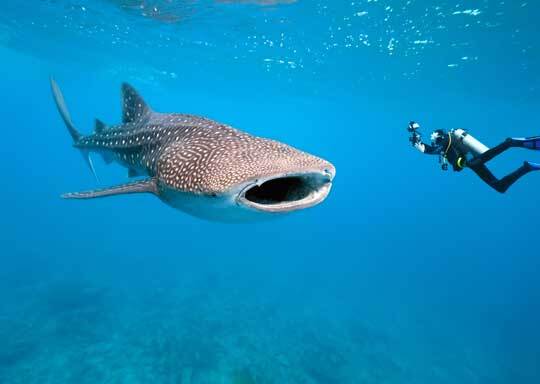
What the heck is a Whale Shark?
First of all, whale sharks (Rhincodon typus) are not whales, they are sharks. As you probably know, whales are mammals (as are humans). Sharks, on the other hand, are fish.
Just because whale sharks are sharks and are huge, that doesn't mean they are dangerous to people. Whale sharks are filter feeders--they filter plankton and small fish from the water. They do not attack and kill large prey. The whale shark is one of only three filter-feeding sharks—the other two are the basking shark and the megamouth shark.
Amazing Facts about Whale Sharks
Let's talk about this unusual filter-feeding habit. Whale sharks cruise along, mile after mile, swimming close to the surface, scooping up plankton in their huge mouths. Most sharks have a mouth that is located under their head, but a whale shark's mouth is situated right up front, to help scoop up all those yummy little plankton animals.
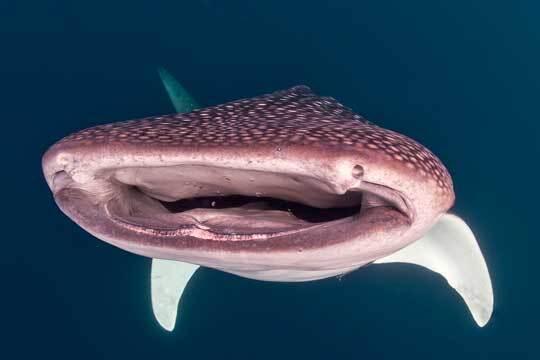
Look at the size of that mouth! When measured, one whale shark that was 40 feet (12 m) long, had a mouth that was 5.1 feet (1.5 m) across. That's one big mouth!
Although they are too small to see in the above photo, whale sharks have about 300 rows of teeny, tiny teeth. Below is a photo of a section of these teeth. Strangely, these teeth have nothing to do with feeding. In fact, they serve little (if any) purpose at all and are therefore considered to be vestigial teeth. The word vestigial refers to body structures that used to be larger and more functional but are in the process of going away over time due to evolution. An example of vestigial structures in humans are the muscles attached to our ears that used to allow our distant ancestors to move their ears, like many other animals can.

So, if these thousands of teeth aren't used, how does a whale shark actually eat? As stated above, they cruise around, scooping up plankton. Sometimes they also actively open and close the mouth, sucking in water. With either method, a large quantity of water rushes into the mouth and is then expelled through the gills. So, what keeps all those yummy plankton animals from getting expelled along with the water? Well, situated on their gills, whale sharks have twenty comb-like structures called filter pads. As the water is expelled through the gills, the plankton and tiny fish get caught in these filter pads. Whenever the filter pads get full, the whale shark swallows all that stuff, making room for more.
Remember that huge mouth? It's easily big enough for a human to swim into (or get sucked into). But even if that happened, the whale shark could not swallow a person because their throats are too narrow to swallow anything bigger than your fist. If you somehow accidentally got sucked into a whale shark's mouth, the shark would probably simply "cough" you back out. Whale sharks are often observed coughing out excess particles that they don't want to eat.
Check out this video about whale sharks.
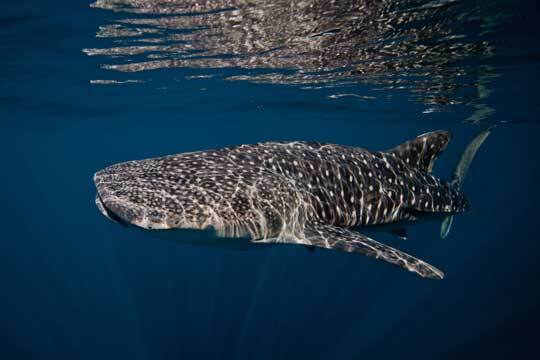
Whale sharks are known to be very docile toward divers, often even allowing divers to grab hold and go for a ride. However, disturbing these magnificent fish in such a way is discouraged by biologists because it puts excess stress on the sharks. But observing them respectfully, even up close, is safe for both the diver and the fish. In fact, divers travel to various sites around the world just for the opportunity to see these creatures.
The whale shark's huge size requires that it find areas with abundant food. These fish are notorious for incredibly long migrations (thousands of miles), in which they arrive at their destination just at the right time for an annual explosion of certain types of plankton. Keep in mind that whale sharks are slow swimmers, moving at only about three miles (4.8 km) per hour. So, such migrations take a looong time!
Whale sharks are usually solitary, but sometimes they are seen swimming in groups of hundreds.
Whale sharks grow really old. Although studying their age is difficult, scientists estimate that whale sharks live between 60 and 100 years, and some experts suggest that they can live up to 150 years.
Because whale sharks are so difficult to study, they have never been observed giving birth. And mating has only been observed twice (from an airplane). However, we can deduce some information on their reproduction from other observations. Based on dissection of female whale sharks, we know these fish are ovoviviparous (have fun pronouncing that one). Ovoviviparous refers to a form of reproduction that is halfway between egg-laying (oviparous) and live birth (viviparous). Ovoviviparous animals have young that develop inside eggs, but the eggs stay inside the female's body until they hatch, and then the live young are born. Cool, huh?
Here's where things get a little confusing. Female whale sharks can have a lot of fertilized eggs in their body at once. One female that was captured in 1996 contained about 300 shark pups. However, the females do not give birth to all these pups at once. Instead, they keep the sperm from one mating inside their body, and they give birth to only a few pups at a time. Apparently they can continue regularly producing pups like this for a long period of time.
Below is the smallest whale shark pup ever found, which implies that this is about the size of newborn pups. This individual was found tied to a stake on a beach in the Philippines (notice the red string tied to its tail). No one knows why it was tied there, or where it came from, but it was measured and released safely into the wild. Because this is the smallest pup ever observed, we assume this is the size of newborn pups. We assume newborn pups are about 18 inches (46 cm) when they are born.

I suppose because I have so many grandkids, I cannot read the phrase "baby shark" without an incredibly annoying song running through my mind endlessly.
Baby shark, doo, doo, doo, doo, doo, doo...
If you don't know what I'm talking about, you're lucky.
So, the Whale Shark deserves a place in the S.A.H.O.F.
(Sublime Animal Hall of Fame).
FUN FACT: Depending on the source, the word sublime originated in the late 1400s or the 1500s. It came from the Latin sublimis, which means "uplifted, high, borne aloft, lofty, exalted, eminent, or distinguished." Today the word sublime has a variety of different meanings. In chemistry, it is a verb meaning "to convert (a solid substance) by heat into a vapor." It also has several uses as an adjective. For example, it can mean "elevated or lofty in thought or language" (example: Stan's novels are sublime literature). It can also mean "impressing the mind with a sense of grandeur" (example: The changing leaves in the fall provides sublime scenery). For our purposes today, though, I am relying on the definition "supreme or outstanding" (example: The whale shark is a sublime fish).
So, sublime is another way to say awesome!
Photo Credits:
- Whale shark #1, next to swimming diver - DepositPhotos
- Whale shark #2, closeup of mouth - DepositPhotos
- Section of whale shark teeth - D Ross Robertson, Public domain, via Wikimedia Commons
- Whale shark #3, swimming near surface against dark background - DepositPhotos
- Baby whale shark - Aquaworld
Whale sharks are the largest living fish. They are also the largest non-mammal vertebrate animal. How large are they? The biggest individual found was almost 19 meters (62 feet) long! If you're wondering about how much these fish weigh, well, very few of the really large ones have been weighed. However, one whale shark that was 39 feet (12 m) long weighed about 33,000 pounds (15,000 kg).
It's time we take a closer look at this gentle giant.

What the heck is a Whale Shark?
First of all, whale sharks (Rhincodon typus) are not whales, they are sharks. As you probably know, whales are mammals (as are humans). Sharks, on the other hand, are fish.
Just because whale sharks are sharks and are huge, that doesn't mean they are dangerous to people. Whale sharks are filter feeders--they filter plankton and small fish from the water. They do not attack and kill large prey. The whale shark is one of only three filter-feeding sharks—the other two are the basking shark and the megamouth shark.
Amazing Facts about Whale Sharks
Let's talk about this unusual filter-feeding habit. Whale sharks cruise along, mile after mile, swimming close to the surface, scooping up plankton in their huge mouths. Most sharks have a mouth that is located under their head, but a whale shark's mouth is situated right up front, to help scoop up all those yummy little plankton animals.

Look at the size of that mouth! When measured, one whale shark that was 40 feet (12 m) long, had a mouth that was 5.1 feet (1.5 m) across. That's one big mouth!
Although they are too small to see in the above photo, whale sharks have about 300 rows of teeny, tiny teeth. Below is a photo of a section of these teeth. Strangely, these teeth have nothing to do with feeding. In fact, they serve little (if any) purpose at all and are therefore considered to be vestigial teeth. The word vestigial refers to body structures that used to be larger and more functional but are in the process of going away over time due to evolution. An example of vestigial structures in humans are the muscles attached to our ears that used to allow our distant ancestors to move their ears, like many other animals can.

So, if these thousands of teeth aren't used, how does a whale shark actually eat? As stated above, they cruise around, scooping up plankton. Sometimes they also actively open and close the mouth, sucking in water. With either method, a large quantity of water rushes into the mouth and is then expelled through the gills. So, what keeps all those yummy plankton animals from getting expelled along with the water? Well, situated on their gills, whale sharks have twenty comb-like structures called filter pads. As the water is expelled through the gills, the plankton and tiny fish get caught in these filter pads. Whenever the filter pads get full, the whale shark swallows all that stuff, making room for more.
Remember that huge mouth? It's easily big enough for a human to swim into (or get sucked into). But even if that happened, the whale shark could not swallow a person because their throats are too narrow to swallow anything bigger than your fist. If you somehow accidentally got sucked into a whale shark's mouth, the shark would probably simply "cough" you back out. Whale sharks are often observed coughing out excess particles that they don't want to eat.
Check out this video about whale sharks.

Whale sharks are known to be very docile toward divers, often even allowing divers to grab hold and go for a ride. However, disturbing these magnificent fish in such a way is discouraged by biologists because it puts excess stress on the sharks. But observing them respectfully, even up close, is safe for both the diver and the fish. In fact, divers travel to various sites around the world just for the opportunity to see these creatures.
The whale shark's huge size requires that it find areas with abundant food. These fish are notorious for incredibly long migrations (thousands of miles), in which they arrive at their destination just at the right time for an annual explosion of certain types of plankton. Keep in mind that whale sharks are slow swimmers, moving at only about three miles (4.8 km) per hour. So, such migrations take a looong time!
Whale sharks are usually solitary, but sometimes they are seen swimming in groups of hundreds.
Whale sharks grow really old. Although studying their age is difficult, scientists estimate that whale sharks live between 60 and 100 years, and some experts suggest that they can live up to 150 years.
Because whale sharks are so difficult to study, they have never been observed giving birth. And mating has only been observed twice (from an airplane). However, we can deduce some information on their reproduction from other observations. Based on dissection of female whale sharks, we know these fish are ovoviviparous (have fun pronouncing that one). Ovoviviparous refers to a form of reproduction that is halfway between egg-laying (oviparous) and live birth (viviparous). Ovoviviparous animals have young that develop inside eggs, but the eggs stay inside the female's body until they hatch, and then the live young are born. Cool, huh?
Here's where things get a little confusing. Female whale sharks can have a lot of fertilized eggs in their body at once. One female that was captured in 1996 contained about 300 shark pups. However, the females do not give birth to all these pups at once. Instead, they keep the sperm from one mating inside their body, and they give birth to only a few pups at a time. Apparently they can continue regularly producing pups like this for a long period of time.
Below is the smallest whale shark pup ever found, which implies that this is about the size of newborn pups. This individual was found tied to a stake on a beach in the Philippines (notice the red string tied to its tail). No one knows why it was tied there, or where it came from, but it was measured and released safely into the wild. Because this is the smallest pup ever observed, we assume this is the size of newborn pups. We assume newborn pups are about 18 inches (46 cm) when they are born.

I suppose because I have so many grandkids, I cannot read the phrase "baby shark" without an incredibly annoying song running through my mind endlessly.
Baby shark, doo, doo, doo, doo, doo, doo...
If you don't know what I'm talking about, you're lucky.
So, the Whale Shark deserves a place in the S.A.H.O.F.
(Sublime Animal Hall of Fame).
FUN FACT: Depending on the source, the word sublime originated in the late 1400s or the 1500s. It came from the Latin sublimis, which means "uplifted, high, borne aloft, lofty, exalted, eminent, or distinguished." Today the word sublime has a variety of different meanings. In chemistry, it is a verb meaning "to convert (a solid substance) by heat into a vapor." It also has several uses as an adjective. For example, it can mean "elevated or lofty in thought or language" (example: Stan's novels are sublime literature). It can also mean "impressing the mind with a sense of grandeur" (example: The changing leaves in the fall provides sublime scenery). For our purposes today, though, I am relying on the definition "supreme or outstanding" (example: The whale shark is a sublime fish).
So, sublime is another way to say awesome!
Photo Credits:
- Whale shark #1, next to swimming diver - DepositPhotos
- Whale shark #2, closeup of mouth - DepositPhotos
- Section of whale shark teeth - D Ross Robertson, Public domain, via Wikimedia Commons
- Whale shark #3, swimming near surface against dark background - DepositPhotos
- Baby whale shark - Aquaworld
Published on November 22, 2021 18:39
November 7, 2021
Awesome Animal - Hammerhead Worm
Due to the Halloween season, I'm going with a rather creepy-themed Awesome Animal today. I present to you the hammerhead worm—the coolest worm most people have never heard of.
There's even a species with Halloween colors (see image below).
Honestly, I didn't know anything about these until recently, and I immediately decided I needed to feature them as an Awesome Animal.
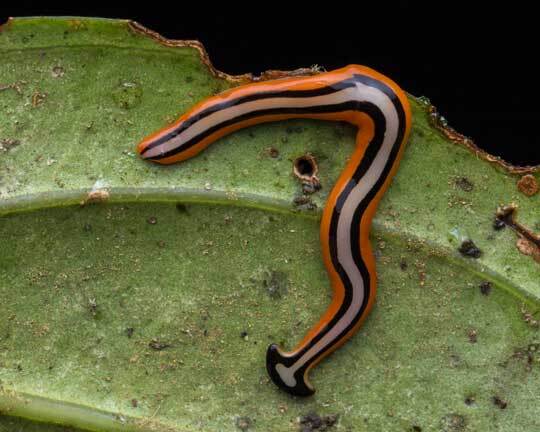
What the heck is a Hammerhead Worm?
Actually, these are not worms like earthworms. Earthworms are segmented worms. Hammerhead worms, on the other hand, are planarians, a type of flatworm . Sometimes they are called broadhead planarians. Another common name—landchovy.
Most species of planarians live in freshwater or saltwater, but some types, like the hammerhead worms, live on land.
Perhaps the most distinguishing characteristic is the broad, shovel-shaped head.
Land planarians have what's called a creeping sole that allows them to move around. This creeping sole is on their ventral (belly) side, and it has a thick layer of cilia (moving, hairlike projections) that beat back and forth on a strip of mucus the worm lays down as it progresses forward.
What, you didn't expect these things to produce copious amounts of slime?
To top it all off, these worms are fierce predators, as well as cannibalistic. Oh, and they are invading North America, Europe, and many other parts of the world.
And... if you cut them into pieces, you end up with more hammerhead worms.
Oh... and some of them grow to 18 inches (half a meter) long.
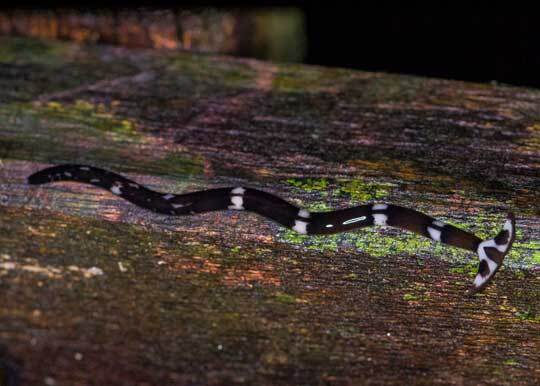
Amazing Facts about Hammerhead Worms
Wait... what was that statement about cutting them up and ending up with more? Planarians are famously good at regeneration. You can literally slice one in half, either lengthwise or across its body, and in two to three weeks each half will grow a new planarian. If you cut one into five pieces, you might get five worms (this depends on several things, including how big the pieces are).
In fact, this splitting is the main way most hammerhead worms reproduce. Yeah, they are capable of sexual reproduction—you know, with a male and female—BUT, hammerhead worms are hermaphroditic, which means each individual has both male and female sexual organs. Therefore, any individual can mate with any other individual. Strangely, though, they usually don't. Instead, they seem to prefer to make new hammerhead worms by splitting their body apart. This is known as fragmentation and is a handy form of asexual reproduction.
How do they split themselves apart? Well, they stick the tail end part of their body to the ground (remember all that slimy mucus?), then they keep moving forward (remember that creeping sole?) until their body tears right in half. The broken piece they leave behind becomes a younger worm, growing longer and developing a broad hammer head in a few weeks. A hammerhead worm can break apart like this one or two times per month.
Lifespan of a hammerhead worm: Potentially immortal.
I know, that's weird, but get this—hammerhead worms have no respiratory system, no circulatory system, no skeleton, and their mouth is also their anus.
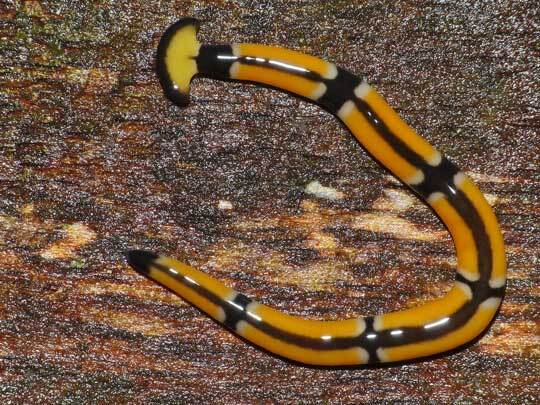
Let's consider those one at a time.
No respiratory system: There's no need. Oxygen enters and carbon dioxide leaves the worm's body by diffusing directly through the body wall.
No circulatory system: There's no need, for the exact same reason as above.
Mouth is also the anus: Now we're talking about the digestive system. It's a simple system. The mouth is located in the center of the ventral (belly) side. Food is taken in there and travels through a pharynx to a gastrovascular cavity, where it is digested, and because this cavity branches out to various parts of the body, that's how the nutrients get everywhere they need to be. Whatever is left over gets spit right back out the mouth. Nice.
Let's talk about how these creatures eat. As I stated above, they are predators. Unfortunately, many of them kill and eat earthworms. In case you didn't know, when it comes to almost every aspect of an ecosystem, earthworms are the good guys. gardeners know you can't have healthy soil without earthworms. That's why invading hammerhead worms could be bad news.
Hammerhead worms are vicious earthworm hunters. They glide around on the ground with their spade-like head held up, moving it back and forth like a radar. The broad head has special chemoreceptors that detect earthworm mucus. When they catch up to one, they subdue it with a coat of their own mucus (wow, there's a lot of mucus in this newsletter), then they tear it up into pieces. The hammerhead worm then extends its pharynx out of its mouth and secretes earthworm-dissolving enzymes all over the chopped-up prey. After the earthworm becomes soup, the predator sucks it all up, digests most of it, and spits the remains back out the mouth.
These creatures are an earthworm's worst nightmare (although it seems unlikely earthworms have nightmares—they have very primitive brains).
Hammerhead worms are also enthusiastically cannibalistic. They like eating each other.

Hammerhead worms are native to Asia and Australasia. However, as I stated above, they are becoming invasive worldwide, probably due to being transported on horticultural plants.
Possible solution: Maybe predators (or even people) could eat them. Nope. Many earthworms are edible, but these creatures are toxic. They contain a potent neurotoxin called tetrodotoxin, which is also found in some newts, pufferfish, and the blue-ringed octopus. Other than each other, they have few predators.
If you pick them up, their surface mucus can cause skin irritation. And, of course, don't even try chopping them up.
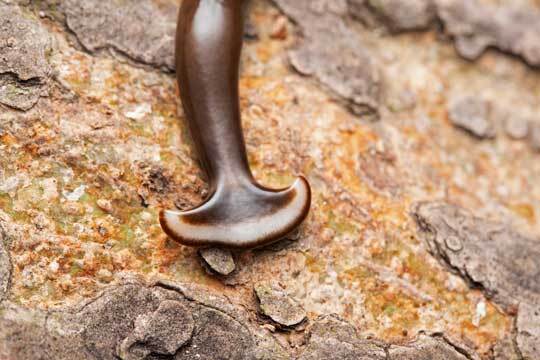
I know... I'm kind of making these creatures out to be overly creepy for this Halloween edition. But keep in mind that in their native habitats, hammerhead worms are important to the ecosystem and should not be killed. They are, after all, awesome animals.
When it comes to invasive hammerhead worms, they could become a problem. If you see an invasive hammerhead worm, you can pick it up with gloves or tweezers and put it in alcohol, or salt, or a sealed container. It might also help to report it to local authorities, who might be tracking sightings in your area.
So, the Hammerhead Worm deserves a place in the E.A.H.O.F.
(Elegant Animal Hall of Fame).
FUN FACT: The word elegant (meaning "tastefully ornate") originated in the late 1400s, and it came from the Old French élégant. Another definition, one that I think applies to the appearance of some of the hammerhead worms, is "graceful in form or movement." Yet another definition is "excellent; fine; superior," as in "This is an elegant wine." I suppose you could consider hammerhead worms to be nothing more than slimy, slug-like things, but you have to admit they have a rather delicate and graceful appearance, right?
So, elegant is another way to say awesome!
Photo Credits:
- Hammerhead worm from Borneo, orange, black, and white - DepositPhotos
- Hammerhead worm, black and white - DepositPhotos
- Hammerhead worm, black and orange #2 - Bernard DUPONT, Flickr, Creative Commons License (CC BY-SA 2.0)
- Hammerhead worm, long, thin, black - "Hammerhead worm - Carita - West Java_IMG_2708" by fveronesi1 is licensed under CC BY-SA 2.0
- Hammerhead worm head, brown and white - DepositPhotos
There's even a species with Halloween colors (see image below).
Honestly, I didn't know anything about these until recently, and I immediately decided I needed to feature them as an Awesome Animal.

What the heck is a Hammerhead Worm?
Actually, these are not worms like earthworms. Earthworms are segmented worms. Hammerhead worms, on the other hand, are planarians, a type of flatworm . Sometimes they are called broadhead planarians. Another common name—landchovy.
Most species of planarians live in freshwater or saltwater, but some types, like the hammerhead worms, live on land.
Perhaps the most distinguishing characteristic is the broad, shovel-shaped head.
Land planarians have what's called a creeping sole that allows them to move around. This creeping sole is on their ventral (belly) side, and it has a thick layer of cilia (moving, hairlike projections) that beat back and forth on a strip of mucus the worm lays down as it progresses forward.
What, you didn't expect these things to produce copious amounts of slime?
To top it all off, these worms are fierce predators, as well as cannibalistic. Oh, and they are invading North America, Europe, and many other parts of the world.
And... if you cut them into pieces, you end up with more hammerhead worms.
Oh... and some of them grow to 18 inches (half a meter) long.

Amazing Facts about Hammerhead Worms
Wait... what was that statement about cutting them up and ending up with more? Planarians are famously good at regeneration. You can literally slice one in half, either lengthwise or across its body, and in two to three weeks each half will grow a new planarian. If you cut one into five pieces, you might get five worms (this depends on several things, including how big the pieces are).
In fact, this splitting is the main way most hammerhead worms reproduce. Yeah, they are capable of sexual reproduction—you know, with a male and female—BUT, hammerhead worms are hermaphroditic, which means each individual has both male and female sexual organs. Therefore, any individual can mate with any other individual. Strangely, though, they usually don't. Instead, they seem to prefer to make new hammerhead worms by splitting their body apart. This is known as fragmentation and is a handy form of asexual reproduction.
How do they split themselves apart? Well, they stick the tail end part of their body to the ground (remember all that slimy mucus?), then they keep moving forward (remember that creeping sole?) until their body tears right in half. The broken piece they leave behind becomes a younger worm, growing longer and developing a broad hammer head in a few weeks. A hammerhead worm can break apart like this one or two times per month.
Lifespan of a hammerhead worm: Potentially immortal.
I know, that's weird, but get this—hammerhead worms have no respiratory system, no circulatory system, no skeleton, and their mouth is also their anus.

Let's consider those one at a time.
No respiratory system: There's no need. Oxygen enters and carbon dioxide leaves the worm's body by diffusing directly through the body wall.
No circulatory system: There's no need, for the exact same reason as above.
Mouth is also the anus: Now we're talking about the digestive system. It's a simple system. The mouth is located in the center of the ventral (belly) side. Food is taken in there and travels through a pharynx to a gastrovascular cavity, where it is digested, and because this cavity branches out to various parts of the body, that's how the nutrients get everywhere they need to be. Whatever is left over gets spit right back out the mouth. Nice.
Let's talk about how these creatures eat. As I stated above, they are predators. Unfortunately, many of them kill and eat earthworms. In case you didn't know, when it comes to almost every aspect of an ecosystem, earthworms are the good guys. gardeners know you can't have healthy soil without earthworms. That's why invading hammerhead worms could be bad news.
Hammerhead worms are vicious earthworm hunters. They glide around on the ground with their spade-like head held up, moving it back and forth like a radar. The broad head has special chemoreceptors that detect earthworm mucus. When they catch up to one, they subdue it with a coat of their own mucus (wow, there's a lot of mucus in this newsletter), then they tear it up into pieces. The hammerhead worm then extends its pharynx out of its mouth and secretes earthworm-dissolving enzymes all over the chopped-up prey. After the earthworm becomes soup, the predator sucks it all up, digests most of it, and spits the remains back out the mouth.
These creatures are an earthworm's worst nightmare (although it seems unlikely earthworms have nightmares—they have very primitive brains).
Hammerhead worms are also enthusiastically cannibalistic. They like eating each other.

Hammerhead worms are native to Asia and Australasia. However, as I stated above, they are becoming invasive worldwide, probably due to being transported on horticultural plants.
Possible solution: Maybe predators (or even people) could eat them. Nope. Many earthworms are edible, but these creatures are toxic. They contain a potent neurotoxin called tetrodotoxin, which is also found in some newts, pufferfish, and the blue-ringed octopus. Other than each other, they have few predators.
If you pick them up, their surface mucus can cause skin irritation. And, of course, don't even try chopping them up.

I know... I'm kind of making these creatures out to be overly creepy for this Halloween edition. But keep in mind that in their native habitats, hammerhead worms are important to the ecosystem and should not be killed. They are, after all, awesome animals.
When it comes to invasive hammerhead worms, they could become a problem. If you see an invasive hammerhead worm, you can pick it up with gloves or tweezers and put it in alcohol, or salt, or a sealed container. It might also help to report it to local authorities, who might be tracking sightings in your area.
So, the Hammerhead Worm deserves a place in the E.A.H.O.F.
(Elegant Animal Hall of Fame).
FUN FACT: The word elegant (meaning "tastefully ornate") originated in the late 1400s, and it came from the Old French élégant. Another definition, one that I think applies to the appearance of some of the hammerhead worms, is "graceful in form or movement." Yet another definition is "excellent; fine; superior," as in "This is an elegant wine." I suppose you could consider hammerhead worms to be nothing more than slimy, slug-like things, but you have to admit they have a rather delicate and graceful appearance, right?
So, elegant is another way to say awesome!
Photo Credits:
- Hammerhead worm from Borneo, orange, black, and white - DepositPhotos
- Hammerhead worm, black and white - DepositPhotos
- Hammerhead worm, black and orange #2 - Bernard DUPONT, Flickr, Creative Commons License (CC BY-SA 2.0)
- Hammerhead worm, long, thin, black - "Hammerhead worm - Carita - West Java_IMG_2708" by fveronesi1 is licensed under CC BY-SA 2.0
- Hammerhead worm head, brown and white - DepositPhotos
Published on November 07, 2021 05:55
October 22, 2021
Awesome Animal - Numbat
I like living in North America, but I've always felt that we are sadly deprived of the splendor of marsupial mammals. I mean, really, we only have ONE marsupial, the Virginia opossum. It's an interesting animal, but come on—only one? Australia is a true wonderland of marsupials. There are about 330 species of marsupials in the world, and Australia has two-thirds of those, about 250. Actually, South America has about 120 marsupial species, which is impressive also, especially compared to our ONE!
Okay, I'm finished with that rant.
Today's Awesome Animal is, not surprisingly, a marsupial mammal. It has the delightful name of Numbat. Actually, I don't know why I think this name is delightful. I just like the way it rolls off the tongue... numbat.
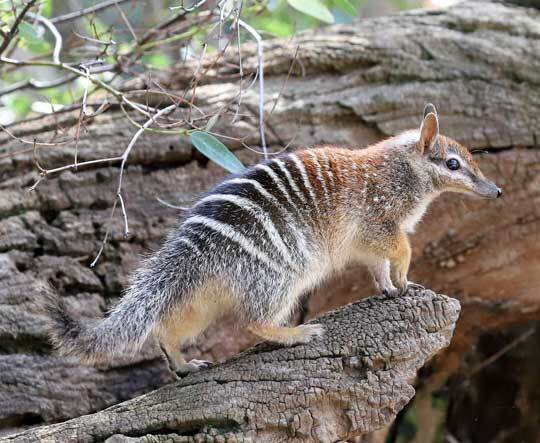
What the heck is a Numbat?
The numbat is not closely related to any of the other living species of marsupial, and it's the only member of its family, Myrmecobiidae (don't blow a fuse trying to pronounce that one). Genetic studies show that the numbat diverged from other marsupials about 37 million years ago. So, it really is unique.
Numbats used to be common over a large area of southern Australia, but (big surprise!), they have been greatly reduced since Europeans arrived there. Now they are endangered and live in only two relatively small areas. This is believed to have been caused almost entirely by the intentional introduction of the European red fox in the 1800s.
Numbats are fairly small, at 14 to 18 inches (35 to 45 cm) in length, including the tail.
They are unusual in that their diet consists almost entirely of termites. In fact, they are highly specialized termite eaters. See the numbat's termite-slurping utensil (otherwise known as its tongue) below.

Amazing Facts about the Numbat
First let's consider what it means to be a marsupial mammal, especially since I made such a fuss about it above. Primates (including humans), rodents, dogs, cats, and many others are called placental mammals. They are called this because of the presence of a placenta, a specialized vascular organ that develops during gestation of the young. The placenta allows the mother to "feed" the fetus and remove waste from the fetus while the fetus is inside the womb. This last part is important because the fetus is much safer inside the womb than outside. It also means baby placental mammals develop to a large size inside the womb, which means giving birth is a rather stressful event for the female.
Placental mammals include all mammals except for marsupials and monotremes. The first placental mammals evolved about 160 million years ago.
How is a marsupial different? Well, many marsupials have a rudimentary placenta, but it is much less efficient than a true placenta. This limits how long the fetus can remain in the womb. So, the babies come out of the womb (they are born) at an early stage of development. For example, a kangaroo baby is born when it is only the size of a jelly bean.
These extremely small young usually have tiny hands that allow them to make their way from the birth canal to an external pouch (called a marsupium). The baby latches its mouth onto a nipple in the marsupium and remains attached to it. There, inside the pouch, the young completes its development by taking in nutrients through the nipple (instead of through a placenta inside the womb).
Imagine this... if humans were marsupials, babies would be born when they are smaller than your thumb. So, no need for all that hassle of going through labor and a stressful birth. The baby then would crawl from the birth canal to the woman's pouch, which would be located about where her belly button would be. Marsupials, of course, do not have a belly button because a belly button is where the placenta was attached. Instead of having breasts on her chest, the mother would have nipples inside the pouch. The baby would then grow inside the pouch until it weighs about seven pounds, at which point the mother would get tired of carrying it around and would ban it from the pouch forever.
Hmm... now I can't get that series of images out of my head. But I digress...
So, numbats are marsupials. However, numbats are among the few marsupials that do not have a pouch. As mating season (December-January) approaches, the males secrete a smelly, red substance from their chest. They rub this stuff all over everything they can find, which is their way of advertising to females that they are looking for mates.
Females give birth to four babies only 14 days after mating (remember, a short gestation is standard for marsupials). The tiny young crawl to the nipples and attach. Remember, numbat nipples are not in a pouch, but the mother does have some small flaps of skin that cover the babies somewhat while they are really small. The babies remain physically attached to the nipples for at least six months, until they are so big that the mother can no longer walk around properly. Then she pulls them loose and deposits them into a nest in a burrow, returning often to continue nursing them. At about nine months, they start wandering out of the burrow.
Below is a young numbat.

Now let's talk about the numbat's diet of termites. Again, this is all they eat—nothing but termites.
When baby numbats are born, their snouts are blunt and pig-like, which helps them attach to the nipple. After they detach from the nipple, though, the snout grows longer so that it can be used to get into small holes in the ground and cavities in logs, where they use their long, sticky tongue to slurp up termites. In fact, they consume as many as 20,000 termites every day! They don't drink water at all because they get all the water they need from the termites they eat.
Because numbats only eat termites, they must live only where termites can live. If an area is too hot or cold or dry or wet for termites, numbats cannot live there. They favor eucalyptus woodlands, where there are plenty of fallen logs full of termites that are feeding on the rotting wood. The forests must be open enough for sunlight to warm up the ground and the logs, which makes the termites active. Because termites are active during the warmer daylight hours, numbats are diurnal (active during the day instead of night). During the hottest afternoon hours, numbats retreat to their burrow for a nap. Why? Because termites move deeper into logs and the ground during these hot hours. In other words, numbat habits are directly linked to termite habits.
Want to know more? Check out this video about numbats.
The below numbat is taking a break from the hard work of hunting termites.

So, the Numbat deserves a place in the W.A.H.O.F.
(Wondrous Animal Hall of Fame).
FUN FACT: The word wondrous originated in the 1400s, and it has always meant "causing wonder or amazement; very beautiful or impressive." It came from the word wonder, which originally was a noun meaning a "marvelous thing" but later became associated with the emotion one feels when witnessing such a thing. The suffix "ous" was added because it was already being used at the end of the similar word marvelous.
So, wondrous is another way to say awesome!
Photo Credits:
- Numbat #1, on a log - DepositPhotos
- Numbat #2, with protruding tongue - DepositPhotos
- Numbat #3, baby in hand - Zooborns
- Numbat #4, lounging on a log - S J Bennett from Australia, CC BY 2.0, via Wikimedia Commons
Okay, I'm finished with that rant.
Today's Awesome Animal is, not surprisingly, a marsupial mammal. It has the delightful name of Numbat. Actually, I don't know why I think this name is delightful. I just like the way it rolls off the tongue... numbat.

What the heck is a Numbat?
The numbat is not closely related to any of the other living species of marsupial, and it's the only member of its family, Myrmecobiidae (don't blow a fuse trying to pronounce that one). Genetic studies show that the numbat diverged from other marsupials about 37 million years ago. So, it really is unique.
Numbats used to be common over a large area of southern Australia, but (big surprise!), they have been greatly reduced since Europeans arrived there. Now they are endangered and live in only two relatively small areas. This is believed to have been caused almost entirely by the intentional introduction of the European red fox in the 1800s.
Numbats are fairly small, at 14 to 18 inches (35 to 45 cm) in length, including the tail.
They are unusual in that their diet consists almost entirely of termites. In fact, they are highly specialized termite eaters. See the numbat's termite-slurping utensil (otherwise known as its tongue) below.

Amazing Facts about the Numbat
First let's consider what it means to be a marsupial mammal, especially since I made such a fuss about it above. Primates (including humans), rodents, dogs, cats, and many others are called placental mammals. They are called this because of the presence of a placenta, a specialized vascular organ that develops during gestation of the young. The placenta allows the mother to "feed" the fetus and remove waste from the fetus while the fetus is inside the womb. This last part is important because the fetus is much safer inside the womb than outside. It also means baby placental mammals develop to a large size inside the womb, which means giving birth is a rather stressful event for the female.
Placental mammals include all mammals except for marsupials and monotremes. The first placental mammals evolved about 160 million years ago.
How is a marsupial different? Well, many marsupials have a rudimentary placenta, but it is much less efficient than a true placenta. This limits how long the fetus can remain in the womb. So, the babies come out of the womb (they are born) at an early stage of development. For example, a kangaroo baby is born when it is only the size of a jelly bean.
These extremely small young usually have tiny hands that allow them to make their way from the birth canal to an external pouch (called a marsupium). The baby latches its mouth onto a nipple in the marsupium and remains attached to it. There, inside the pouch, the young completes its development by taking in nutrients through the nipple (instead of through a placenta inside the womb).
Imagine this... if humans were marsupials, babies would be born when they are smaller than your thumb. So, no need for all that hassle of going through labor and a stressful birth. The baby then would crawl from the birth canal to the woman's pouch, which would be located about where her belly button would be. Marsupials, of course, do not have a belly button because a belly button is where the placenta was attached. Instead of having breasts on her chest, the mother would have nipples inside the pouch. The baby would then grow inside the pouch until it weighs about seven pounds, at which point the mother would get tired of carrying it around and would ban it from the pouch forever.
Hmm... now I can't get that series of images out of my head. But I digress...
So, numbats are marsupials. However, numbats are among the few marsupials that do not have a pouch. As mating season (December-January) approaches, the males secrete a smelly, red substance from their chest. They rub this stuff all over everything they can find, which is their way of advertising to females that they are looking for mates.
Females give birth to four babies only 14 days after mating (remember, a short gestation is standard for marsupials). The tiny young crawl to the nipples and attach. Remember, numbat nipples are not in a pouch, but the mother does have some small flaps of skin that cover the babies somewhat while they are really small. The babies remain physically attached to the nipples for at least six months, until they are so big that the mother can no longer walk around properly. Then she pulls them loose and deposits them into a nest in a burrow, returning often to continue nursing them. At about nine months, they start wandering out of the burrow.
Below is a young numbat.

Now let's talk about the numbat's diet of termites. Again, this is all they eat—nothing but termites.
When baby numbats are born, their snouts are blunt and pig-like, which helps them attach to the nipple. After they detach from the nipple, though, the snout grows longer so that it can be used to get into small holes in the ground and cavities in logs, where they use their long, sticky tongue to slurp up termites. In fact, they consume as many as 20,000 termites every day! They don't drink water at all because they get all the water they need from the termites they eat.
Because numbats only eat termites, they must live only where termites can live. If an area is too hot or cold or dry or wet for termites, numbats cannot live there. They favor eucalyptus woodlands, where there are plenty of fallen logs full of termites that are feeding on the rotting wood. The forests must be open enough for sunlight to warm up the ground and the logs, which makes the termites active. Because termites are active during the warmer daylight hours, numbats are diurnal (active during the day instead of night). During the hottest afternoon hours, numbats retreat to their burrow for a nap. Why? Because termites move deeper into logs and the ground during these hot hours. In other words, numbat habits are directly linked to termite habits.
Want to know more? Check out this video about numbats.
The below numbat is taking a break from the hard work of hunting termites.

So, the Numbat deserves a place in the W.A.H.O.F.
(Wondrous Animal Hall of Fame).
FUN FACT: The word wondrous originated in the 1400s, and it has always meant "causing wonder or amazement; very beautiful or impressive." It came from the word wonder, which originally was a noun meaning a "marvelous thing" but later became associated with the emotion one feels when witnessing such a thing. The suffix "ous" was added because it was already being used at the end of the similar word marvelous.
So, wondrous is another way to say awesome!
Photo Credits:
- Numbat #1, on a log - DepositPhotos
- Numbat #2, with protruding tongue - DepositPhotos
- Numbat #3, baby in hand - Zooborns
- Numbat #4, lounging on a log - S J Bennett from Australia, CC BY 2.0, via Wikimedia Commons
Published on October 22, 2021 05:15
October 8, 2021
Awesome Animal - Stonefish
I hope you don't mind, but I'm continuing this weird theme of featuring venomous animals. After all, being venomous is a rather fascinating adaptation for survival, don't you think?
Did you know there are venomous fish? This is not to be confused with poisonous fish. Poisonous and venomous are not the same thing. Poison is a toxin that gets into the body by eating it, inhaling it, or absorbing it through the skin. Venom is a toxin that is injected, usually by fangs, a stinger, or some kind of barb. Very few (if any) snakes are poisonous, but some are venomous. Some plants are poisonous because they have toxins in their berries, leaves, or stems that will make you sick if you eat them. But they do not inject the toxins, so they are not venomous.
Stonefish are the most venomous fish we know of. Their venom protects them from predators, and it is injected by the sharp spines of their dorsal fin.
Masters of disguise, their bumpy skin and drab colors often make them look like an algae-covered stone.

What the heck is a Stonefish?
The stonefish include five species in the family Synanceiidae. They live mostly in coral reef waters in the Indo-Pacific (around Australia, New Guinea, Indonesia, and the Red Sea and Indian Ocean).
These fish grow up to 20 inches (50 cm) long, and they have a huge, upturned mouth. They do not have scales, but their skin often has warty bumps and protrusions and filaments that look like algae growing on a rock. Even their eyes can look like algae. And these fish can change their colors to better blend in with whatever the surroundings look like at the time.
Stonefish sit very still, often half buried in the sand, and wait for prey to wander by.
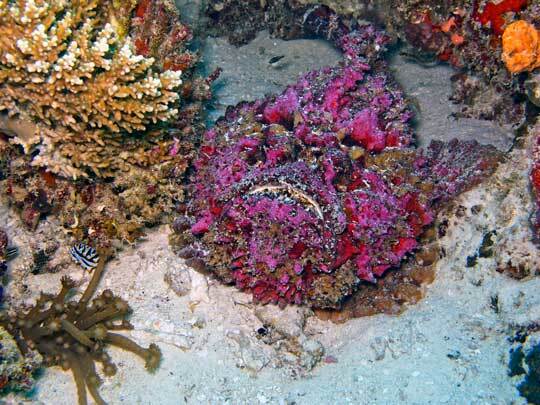
Amazing Facts about Stonefish
First, we need to talk about this fish's nasty habit of protecting itself with dangerous venom. Is it really the most venomous fish in the world? Yes, according to most sources. The venom is produced by special glands located at the base of each of the thirteen spines of the dorsal fin. The venom is conducted through ducts along each spine to the spine's sharp tip.
Typically, these spines are hidden, covered by the camouflaged skin. But when the fish is alarmed, it erects its dorsal fin. If something (like a stingray's mouth or a human's foot) puts pressure on the fish, this forces the skin back, and the needle-like spines penetrate and inject the venom. The more pressure applied to the fish, the more venom is released.
Stonefish venom is amazingly dangerous—it can even be fatal to humans if not treated properly with anti-venom. The results of a sting begin with agonizing pain and swelling, and bad stings can lead to necrosis, paralysis, and even heart failure.
Most human stings occur when swimmers accidentally step on a stonefish. Australia has the highest number of stonefish stings, with about 25 cases per year that are bad enough to administer anti-venom. Human deaths are rare, probably because of the availability of anti-venom, but numerous swimmers suffer the pain of stings that do not warrant the use of anti-venom.
Some aboriginal Australians have traditional ceremonies, called corroborees, in which they re-enact the events of one of their members stepping on a stonefish and dying from the sting. This is a traditional way of teaching their children about the dangers of this fish.
The stonefish uses its venom only as a defense, never for killing or capturing prey. I suppose that makes sense... how could a stonefish possibly jab the spines in the middle of its back into a fish it is trying to catch? Stonefish are obviously well camouflaged, but this is mainly to help them ambush prey. They still get attacked by predators, particularly sharks, stingrays, and sea snakes. That's when their venom helps protect them.
We don't know this for sure, but it is thought that sea snakes are immune to stonefish venom. Sea snake venom, however, is dangerous to stonefish, and after a sea snake bites, the stonefish becomes immobile, and the sea snake can swallow it without the fish's spines sticking up and getting in the way or causing damage.
Stonefish may spend most of their time sitting still and waiting, but when a prey fish or shrimp comes along, the attack comes really fast. They can grab and swallow the prey in as little as 0.015 second!
Check out this video about stonefish attacking prey.

Stonefish sometimes get stranded out of water, completely or partially, at low tide. This usually isn't a problem for them, though, because they can survive for up to 24 hours by absorbing oxygen through their skin. As a result, many of the human stings actually occur on the beach instead of in the water. It's easy to imagine how this could happen—among the exposed coral stones at low tide, a stonefish would be difficult to spot.
Stonefish are solitary animals, spending most of their lives alone except when it is time to mate. When a male finds a receptive female, the female releases her eggs into the water. The male then swims over the eggs and releases sperm onto them. The eggs hatch in only three days, but the young are vulnerable to predators and few of them survive.
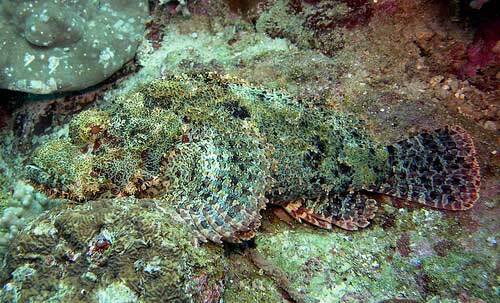
Stonefish venom is a protein, so it breaks down when heated. If properly cooked, these fish can be eaten by people and are considered a delicacy in many parts of Asia. Actually, they are often eaten raw, although—not surprisingly—the dorsal spines are carefully removed beforehand.
So, the Stonefish deserves a place in the N.U.A.H.O.F.
(Numero Uno Animal Hall of Fame).
FUN FACT: The phrase numero uno literally means number one. The phrase was borrowed from Italian into English in the early 1970s. In Spanish, número uno means the same thing and is pronounced the same. Typically, in the English language, it has been used the same way number one is used, and is often used to refer to oneself or one's best interests, as in "He's always looking out for numero uno." It is also used to refer to someone or something that is ranked highest, as in "The Kansas City Chiefs are numero uno." Finally, the phrase is often used as an adjective to describe anything or anyone that is impressive or best at something, as in "The stonefish is the numero uno venomous fish in the world."
So, more or less, numero uno is another way to say awesome!
Photo Credits:
- Stonefish #1, gray and orange - DepositPhotos
- Stonefish #2, with purple splotches - DepositPhotos
- Stonefish #3, orange and red, with fins spread - DepositPhotos
- Stonefish #4, facing to the left - "Stonefish 33" by High Desert Rider, licensed under CC BY-NC-ND 2.0
Did you know there are venomous fish? This is not to be confused with poisonous fish. Poisonous and venomous are not the same thing. Poison is a toxin that gets into the body by eating it, inhaling it, or absorbing it through the skin. Venom is a toxin that is injected, usually by fangs, a stinger, or some kind of barb. Very few (if any) snakes are poisonous, but some are venomous. Some plants are poisonous because they have toxins in their berries, leaves, or stems that will make you sick if you eat them. But they do not inject the toxins, so they are not venomous.
Stonefish are the most venomous fish we know of. Their venom protects them from predators, and it is injected by the sharp spines of their dorsal fin.
Masters of disguise, their bumpy skin and drab colors often make them look like an algae-covered stone.

What the heck is a Stonefish?
The stonefish include five species in the family Synanceiidae. They live mostly in coral reef waters in the Indo-Pacific (around Australia, New Guinea, Indonesia, and the Red Sea and Indian Ocean).
These fish grow up to 20 inches (50 cm) long, and they have a huge, upturned mouth. They do not have scales, but their skin often has warty bumps and protrusions and filaments that look like algae growing on a rock. Even their eyes can look like algae. And these fish can change their colors to better blend in with whatever the surroundings look like at the time.
Stonefish sit very still, often half buried in the sand, and wait for prey to wander by.

Amazing Facts about Stonefish
First, we need to talk about this fish's nasty habit of protecting itself with dangerous venom. Is it really the most venomous fish in the world? Yes, according to most sources. The venom is produced by special glands located at the base of each of the thirteen spines of the dorsal fin. The venom is conducted through ducts along each spine to the spine's sharp tip.
Typically, these spines are hidden, covered by the camouflaged skin. But when the fish is alarmed, it erects its dorsal fin. If something (like a stingray's mouth or a human's foot) puts pressure on the fish, this forces the skin back, and the needle-like spines penetrate and inject the venom. The more pressure applied to the fish, the more venom is released.
Stonefish venom is amazingly dangerous—it can even be fatal to humans if not treated properly with anti-venom. The results of a sting begin with agonizing pain and swelling, and bad stings can lead to necrosis, paralysis, and even heart failure.
Most human stings occur when swimmers accidentally step on a stonefish. Australia has the highest number of stonefish stings, with about 25 cases per year that are bad enough to administer anti-venom. Human deaths are rare, probably because of the availability of anti-venom, but numerous swimmers suffer the pain of stings that do not warrant the use of anti-venom.
Some aboriginal Australians have traditional ceremonies, called corroborees, in which they re-enact the events of one of their members stepping on a stonefish and dying from the sting. This is a traditional way of teaching their children about the dangers of this fish.
The stonefish uses its venom only as a defense, never for killing or capturing prey. I suppose that makes sense... how could a stonefish possibly jab the spines in the middle of its back into a fish it is trying to catch? Stonefish are obviously well camouflaged, but this is mainly to help them ambush prey. They still get attacked by predators, particularly sharks, stingrays, and sea snakes. That's when their venom helps protect them.
We don't know this for sure, but it is thought that sea snakes are immune to stonefish venom. Sea snake venom, however, is dangerous to stonefish, and after a sea snake bites, the stonefish becomes immobile, and the sea snake can swallow it without the fish's spines sticking up and getting in the way or causing damage.
Stonefish may spend most of their time sitting still and waiting, but when a prey fish or shrimp comes along, the attack comes really fast. They can grab and swallow the prey in as little as 0.015 second!
Check out this video about stonefish attacking prey.

Stonefish sometimes get stranded out of water, completely or partially, at low tide. This usually isn't a problem for them, though, because they can survive for up to 24 hours by absorbing oxygen through their skin. As a result, many of the human stings actually occur on the beach instead of in the water. It's easy to imagine how this could happen—among the exposed coral stones at low tide, a stonefish would be difficult to spot.
Stonefish are solitary animals, spending most of their lives alone except when it is time to mate. When a male finds a receptive female, the female releases her eggs into the water. The male then swims over the eggs and releases sperm onto them. The eggs hatch in only three days, but the young are vulnerable to predators and few of them survive.

Stonefish venom is a protein, so it breaks down when heated. If properly cooked, these fish can be eaten by people and are considered a delicacy in many parts of Asia. Actually, they are often eaten raw, although—not surprisingly—the dorsal spines are carefully removed beforehand.
So, the Stonefish deserves a place in the N.U.A.H.O.F.
(Numero Uno Animal Hall of Fame).
FUN FACT: The phrase numero uno literally means number one. The phrase was borrowed from Italian into English in the early 1970s. In Spanish, número uno means the same thing and is pronounced the same. Typically, in the English language, it has been used the same way number one is used, and is often used to refer to oneself or one's best interests, as in "He's always looking out for numero uno." It is also used to refer to someone or something that is ranked highest, as in "The Kansas City Chiefs are numero uno." Finally, the phrase is often used as an adjective to describe anything or anyone that is impressive or best at something, as in "The stonefish is the numero uno venomous fish in the world."
So, more or less, numero uno is another way to say awesome!
Photo Credits:
- Stonefish #1, gray and orange - DepositPhotos
- Stonefish #2, with purple splotches - DepositPhotos
- Stonefish #3, orange and red, with fins spread - DepositPhotos
- Stonefish #4, facing to the left - "Stonefish 33" by High Desert Rider, licensed under CC BY-NC-ND 2.0
Published on October 08, 2021 12:59
September 24, 2021
Awesome Animal - Slow Loris
In my previous Awesome Animal feature I talked about the solenodon, an unusual venomous mammal. Venom is extremely rare in mammals, so I thought it would be fun to look at another example, the slow loris.
Okay, that's not quite true. The real reason I wanted to feature the slow loris is that I just love the way this critter looks. Huge, round, saucer eyes. Funny hands and feet. Round faces... they are Earth's version of the Ewok, only much cuter.
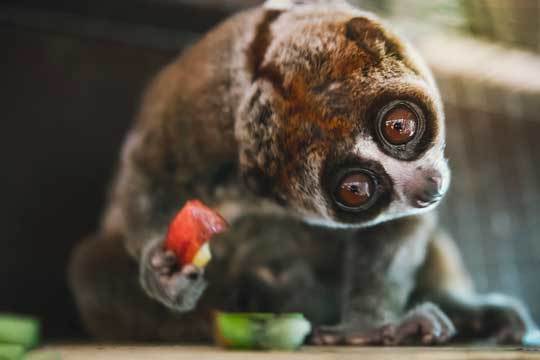
What the heck is a Slow Loris?
Slow lorises are an unusual, primitive group of primates (primates is the order of mammals that includes humans, chimps, gorillas, orangutans, gibbons, new and old world monkeys, tarsiers, lemurs, and lorises). The eight species of slow loris live throughout Southeast Asia. They are nocturnal, tree-dwelling mammals that eat just about anything, including small animals, eggs, fruits, tree sap, flower nectar, and leafy vegetation.
They are generally slow-moving, but they can be fast if they want to... apparently they rarely want to. They make their way through the tropical forest canopy at a snail's pace, and like sloths, they will often become motionless for hours at a time, hanging upside down from a branch with hands and feet that seem to never get tired of holding on.
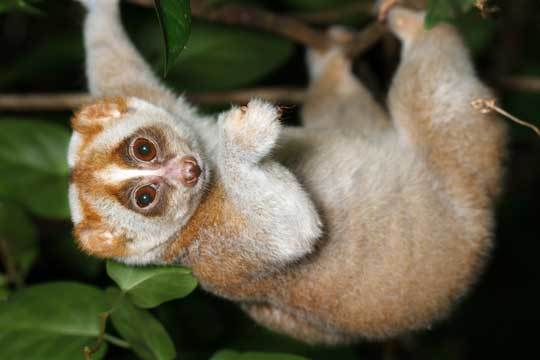
Amazing Facts about the Slow Loris
First we need to talk about why we consider these animals to be venomous. If you read my previous email about solenodons, you may remember that only a few mammals are considered venomous. There are solenodons, of course, as well as two species of shrew. Vampire bats could be considered venomous because their saliva has compounds that prevent blood from clotting. And the male platypus can inject venom with spurs on its feet.
The slow loris has a bizarre way of getting venom onto its teeth. Instead of having venom glands in their mouth, slow lorises get their venom from their armpits. When a slow loris decides it needs to be aggressive, it quickly raises its arms high, locks its hands together above its head, sticks its face into its armpit, and licks the oil-secreting venom glands located there. The venomous oil collects in the narrow grooves in the loris's teeth, which are sharp enough to slice right into bone. Then, when the creature bites, the venom is injected.
Slow loris venom isn't completely understood yet, but we do know one component is similar to the protein that is found in cat dander that triggers severe allergic reactions in many humans. But that's only one of many substances in the venom. Others are known to cause other problems, including intense pain.
Oddly, the purpose of this venom has been poorly understood until recently. It is not for subduing its prey—lorises eat mostly tree sap, vegetation, and small animals that would not need to be subdued. For some time, the leading hypothesis was that it was for defense against predators. As it turns out, this is not the case either.
For years, there has been anecdotal evidence that slow lorises were dangerous to each other. Zoo and animal rescue workers report that the most frequent cause of death among slow lorises is from biting each other. Illegal pet traders report that they routinely remove the teeth from captive lorises they intend to sell. Why? Not to protect the human handlers, but to protect the lorises from each other. Loris venom causes necrosis (death of the tissue near the bite), and bitten lorises would die or lose large portions of their skin, making them difficult to sell (yes, I agree... this illegal pet trade is terrible).
Recently, a dedicated team of researchers put radio collars on 82 Javan slow lorises and spent eight years tracking and studying them! Only one of these lorises was lost to a predator (a feral dog), but many of them suffered from severe bite wounds from other lorises.
So, what is the conclusion? Slow lorises are extremely territorial, and they use their nasty venom primarily in territorial disputes, or disputes over potential mates. Slow lorises, in other words, are constantly in conflict with each other! They are remarkably cute, but looks can be deceiving.
There are some viral videos of people "tickling" a slow loris. The creature raises its arms above its head, and the video claims the loris really likes to be tickled. Umm... no. When a slow loris raises its arms, it is frightened and being defensive!
Check out this video about the slow loris.
Oddly, slow lorises are usually reluctant to bite humans.

For hundreds of years, slow lorises have had interesting and often problematic connections with humans. One of the better stories is from Borneo. The indigenous people in Borneo believed slow lorises were gatekeepers to the heavens, and that every person had their own slow loris assigned to them, which would be waiting to great them in the afterlife. Malay people believed slow lorises were plagued by ghosts, and that was why they often covered their face and eyes with their hands.

Unfortunately, many of the other human connections are more harmful to slow lorises. They have traditionally been hunted based on various beliefs that their body parts could be used for all manner of health benefits. The body parts were thought to bring a curse to enemies if buried under a house or a road where the enemy frequents. The list goes on and on... In Java, women believed if they put a slow loris skull in a jug of water, the water would make their husband more agreeable and docile (because slow lorises themselves are agreeable and docile). In Cambodia, it was thought that slow lorises had medicinal powers because they could never be killed with only one hit with a stick. Slow loris meat has long been eaten as an aphrodisiac (but only for men, not women).
In their natives ranges, slow lorises are often kept for pets (usually illegally). In Indonesia, they are thought of as a living toy for young children. As you can imagine, many of these lorises die from mistreatment. Pet sellers often remove their teeth, frequently resulting in death from bleeding. Fortunately, slow lorises are now protected from international trade, and all countries in which they live have laws to protect them from local trade (although illegal collecting still occurs).

So, the Slow Loris deserves a place in the M.A.H.O.F.
(Marvelous Animal Hall of Fame).
FUN FACT: The word marvelous originated in about 1300. It came from the Middle French merveilleus, originally meaning "causing wonder, of wonderful appearance or quality." Marvel comes from the Latin mīrābilis, meaning “to marvel or wonder at.” Adding the suffix -ous turns it into an adjective (the suffix means “possessing”). Marvelous can also mean "improbable or incredible," as in "the marvelous events of Greek myth."
So, marvelous is another way to say awesome!
Photo Credits:
- Slow loris with piece of apple in hand - DepositPhotos
- Slow loris hanging upside down - DepositPhotos
- Woman holding slow loris - DepositPhotos
- Slow loris (last photo) with rust-colored fur - DepositPhotos
Okay, that's not quite true. The real reason I wanted to feature the slow loris is that I just love the way this critter looks. Huge, round, saucer eyes. Funny hands and feet. Round faces... they are Earth's version of the Ewok, only much cuter.

What the heck is a Slow Loris?
Slow lorises are an unusual, primitive group of primates (primates is the order of mammals that includes humans, chimps, gorillas, orangutans, gibbons, new and old world monkeys, tarsiers, lemurs, and lorises). The eight species of slow loris live throughout Southeast Asia. They are nocturnal, tree-dwelling mammals that eat just about anything, including small animals, eggs, fruits, tree sap, flower nectar, and leafy vegetation.
They are generally slow-moving, but they can be fast if they want to... apparently they rarely want to. They make their way through the tropical forest canopy at a snail's pace, and like sloths, they will often become motionless for hours at a time, hanging upside down from a branch with hands and feet that seem to never get tired of holding on.

Amazing Facts about the Slow Loris
First we need to talk about why we consider these animals to be venomous. If you read my previous email about solenodons, you may remember that only a few mammals are considered venomous. There are solenodons, of course, as well as two species of shrew. Vampire bats could be considered venomous because their saliva has compounds that prevent blood from clotting. And the male platypus can inject venom with spurs on its feet.
The slow loris has a bizarre way of getting venom onto its teeth. Instead of having venom glands in their mouth, slow lorises get their venom from their armpits. When a slow loris decides it needs to be aggressive, it quickly raises its arms high, locks its hands together above its head, sticks its face into its armpit, and licks the oil-secreting venom glands located there. The venomous oil collects in the narrow grooves in the loris's teeth, which are sharp enough to slice right into bone. Then, when the creature bites, the venom is injected.
Slow loris venom isn't completely understood yet, but we do know one component is similar to the protein that is found in cat dander that triggers severe allergic reactions in many humans. But that's only one of many substances in the venom. Others are known to cause other problems, including intense pain.
Oddly, the purpose of this venom has been poorly understood until recently. It is not for subduing its prey—lorises eat mostly tree sap, vegetation, and small animals that would not need to be subdued. For some time, the leading hypothesis was that it was for defense against predators. As it turns out, this is not the case either.
For years, there has been anecdotal evidence that slow lorises were dangerous to each other. Zoo and animal rescue workers report that the most frequent cause of death among slow lorises is from biting each other. Illegal pet traders report that they routinely remove the teeth from captive lorises they intend to sell. Why? Not to protect the human handlers, but to protect the lorises from each other. Loris venom causes necrosis (death of the tissue near the bite), and bitten lorises would die or lose large portions of their skin, making them difficult to sell (yes, I agree... this illegal pet trade is terrible).
Recently, a dedicated team of researchers put radio collars on 82 Javan slow lorises and spent eight years tracking and studying them! Only one of these lorises was lost to a predator (a feral dog), but many of them suffered from severe bite wounds from other lorises.
So, what is the conclusion? Slow lorises are extremely territorial, and they use their nasty venom primarily in territorial disputes, or disputes over potential mates. Slow lorises, in other words, are constantly in conflict with each other! They are remarkably cute, but looks can be deceiving.
There are some viral videos of people "tickling" a slow loris. The creature raises its arms above its head, and the video claims the loris really likes to be tickled. Umm... no. When a slow loris raises its arms, it is frightened and being defensive!
Check out this video about the slow loris.
Oddly, slow lorises are usually reluctant to bite humans.

For hundreds of years, slow lorises have had interesting and often problematic connections with humans. One of the better stories is from Borneo. The indigenous people in Borneo believed slow lorises were gatekeepers to the heavens, and that every person had their own slow loris assigned to them, which would be waiting to great them in the afterlife. Malay people believed slow lorises were plagued by ghosts, and that was why they often covered their face and eyes with their hands.

Unfortunately, many of the other human connections are more harmful to slow lorises. They have traditionally been hunted based on various beliefs that their body parts could be used for all manner of health benefits. The body parts were thought to bring a curse to enemies if buried under a house or a road where the enemy frequents. The list goes on and on... In Java, women believed if they put a slow loris skull in a jug of water, the water would make their husband more agreeable and docile (because slow lorises themselves are agreeable and docile). In Cambodia, it was thought that slow lorises had medicinal powers because they could never be killed with only one hit with a stick. Slow loris meat has long been eaten as an aphrodisiac (but only for men, not women).
In their natives ranges, slow lorises are often kept for pets (usually illegally). In Indonesia, they are thought of as a living toy for young children. As you can imagine, many of these lorises die from mistreatment. Pet sellers often remove their teeth, frequently resulting in death from bleeding. Fortunately, slow lorises are now protected from international trade, and all countries in which they live have laws to protect them from local trade (although illegal collecting still occurs).

So, the Slow Loris deserves a place in the M.A.H.O.F.
(Marvelous Animal Hall of Fame).
FUN FACT: The word marvelous originated in about 1300. It came from the Middle French merveilleus, originally meaning "causing wonder, of wonderful appearance or quality." Marvel comes from the Latin mīrābilis, meaning “to marvel or wonder at.” Adding the suffix -ous turns it into an adjective (the suffix means “possessing”). Marvelous can also mean "improbable or incredible," as in "the marvelous events of Greek myth."
So, marvelous is another way to say awesome!
Photo Credits:
- Slow loris with piece of apple in hand - DepositPhotos
- Slow loris hanging upside down - DepositPhotos
- Woman holding slow loris - DepositPhotos
- Slow loris (last photo) with rust-colored fur - DepositPhotos
Published on September 24, 2021 15:50
September 12, 2021
Awesome Animal - Solenodon
Thanks to Jay Dell for suggestion this awesome animal.
When we think of venomous animals, we usually imagine venomous snakes and spiders. We don 't think of mammals. However, there are a few mammals known to be venomous. The male platypus can inject venom with spurs on its feet. Vampire bats have saliva that prevents clotting and is considered a form of venom. The slow loris has a strange combination of two venoms, one from its legs and one in its saliva, and when mixed together they become even more potent. Hedgehogs can be considered venomous because they intentionally smear toxic substances on their spines, which then get into the bodies of animals trying to attack them.
Several species of shrews are definitely venomous—when biting their prey, they can inject venom that gathers in concave pits in their incisors.
One type of rare mammal, though, has distinct channels in its teeth that deliver venom when it bites. This mammal is the solenodon .
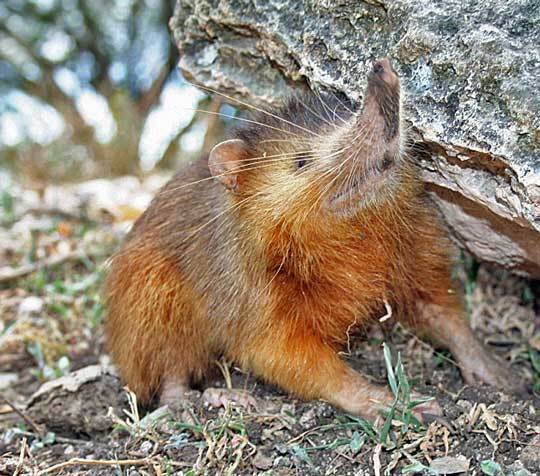
What the heck is a Solenodon?
Among the rarest mammals in the world, solenodons are insectivorous, burrowing mammals. Although many species used to live throughout North America 30 million years ago, now only two species remain, the Cuban solenodon and the Hispaniola solenodon.
Their closest living relatives are shrews, and although solenodons kind of resemble very large shrews, they are not as closely related as you might think. In fact, these creatures diverged from other mammals (including shrews) about 73 million years ago. Think of it... these animals were around, in about the same form they are today, 7 million years before the massive, astroid-related extinction event that wiped out the dinosaurs (it happened 66 million years ago).
DNA analysis has shown that Solenodons split apart from the lineage that eventually became the hedgehogs, moles, and shrews. But that split happened a loooong time ago.
Solenodons may slightly resemble shrews in shape, but they are much larger than shrews. They typically are 11 to 13 inches (28 to 32 cm) long (not including the tail) and weigh 1.5. to 2.2 pounds (0.7 to 1 kg). The photo below of a Hispaniolan solenodon gives you an idea of their size. Solenodon venom is not lethal to humans, but notice the handler is still wearing gloves... good idea.
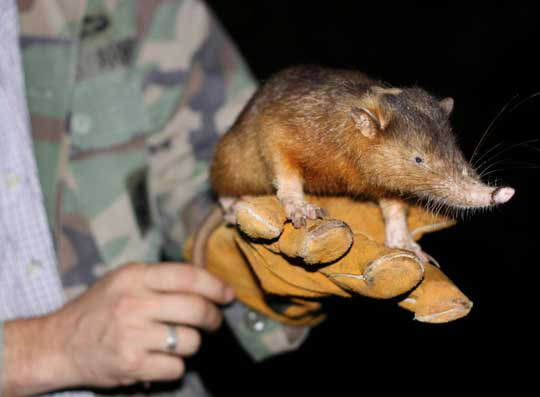
Amazing Facts about Solenodons
First we need to talk about that venom! Here's how it works. Solenodons have modified, enlarged salivary glands in their mandible (the lower, movable jaw bone). This saliva, which happens to also be the venom, flows through specialized grooves in the lower incisors into the solenodon's prey. So, solenodons are among the very few mammals that actually inject venom, similar to how a venomous snake injects its venom. Solenodons, however, only inject venom through their lower teeth.
Recent studies have shown that solenodon saliva (the venom) contains a set of enzymes called kallikreins. These enzymes break down certain proteins, including proteins that help maintain blood pressure. When researchers injected the saliva into mice, their blood pressure immediately dropped drastically. This might be directly fatal to the solenodon's prey, or it would at least make the prey lethargic and easier to kill.
Interestingly, some shrews also have kallikreins in their saliva, which also acts as venom. At first thought, you would assume solenodons and shrews got this similar characteristic from a shared ancestor. However, this is not the case, particularly because these groups diverged 73 million years ago. As it turns out, the two groups evolved this venom ability independently of each other... a fascinating example of convergent evolution (when different organisms develop similar traits even though they are isolated from each other).
An interesting side note on this—it's possible that solenodons do not have the opportunity to actually use their venom much anymore. Why? Because the venom is most effective on prey animals that are vertebrates, such as rodents, lizards, and birds. Unfortunately, during the last 500 years many of these prey animals have been wiped out in Cuba and Hispaniola (the island that includes Haiti and the Dominican Republic) by humans. Now solenodons are forced to mainly eat insects, which are not affected by the venom in the same way.
Sadly, solenodons are adapted to an ecosystem that no longer exists.
Check out this video about how solenodons became venomous.

Solenodons have supersnouts. Take a closer look above at the creature's nearly hairless snout. You know how some people can (kind of) wiggle their nose? Well, solenodons are really good at this. Their nose is like a highly sensitive finger they can move back and forth. Solenodons, in fact, have a ball-and-socket joint at the base of the nose, kind of like a human shoulder joint, which gives the nose even more movement.
This amazingly moveable schnoz helps the solenodon investigate small holes and narrow crevices in search of prey. Solenodons have tiny, poorly developed eyes, and they hunt mostly by smell and touch.
Solenodons smell like goats. That's right—goats. Why? Because they have special glands in their armpits and groin that secrete a substance that, well, smells like a goat. Personally, I haven't been around goats enough to know what they smell like, but apparently some people who have handled solenodons do know what goats smell like.
Solenodons are rare and difficult to find or study, so very little is known about their habits. They're nocturnal, spending the daylight hours hidden away in burrows or hollow logs.
Unfortunately, there are far fewer solenodons than there used to be. When Europeans arrived on the Caribbean islands, they introduced dogs, cats, rats, and mongooses, all of which are threats to solenodons. Human development has also greatly fragmented and reduced the habitat of these creatures.
Solenodons give birth to one or two young. If three are born, one will almost certainly die. Why? Because the mother only has two nipples (which, oddly, are situated way back near her rump). If three are born, one will become malnourished and eventually die, allowing the other two to develop normally.
One last tidbit of information... solenodons are featured on postage stamps in the Dominican Republic (the Hispaniola solenodon) and in Cuba (the Cuban solenodon).

So, the Solenodon deserves a place in the J.D.A.H.O.F.
(Jaw-dropping Animal Hall of Fame).
FUN FACT: The phrase jaw-dropping first showed up in the Oxford English Dictionary in 1900. It means "causing astonishment or surprise; amazing." This one is pretty easy to figure out, as it is simply a reference to a person’s mouth open wide in amazement or shock. Sometimes it is spelled without a hyphen (jawdropping), but the hyphenated form is most common. There is only one derived form, the adverb jaw-droppingly (as in, "The solenodon has remained unchanged for a jaw-droppingly vast amount of time—73 million years.).
So, jaw-dropping is another way to say awesome!
Photo Credits:
- Solenodon beside rock - Seb az86556, CC BY-SA 3.0, via Wikimedia Commons
- Hispaniolan solenodon held in gloved hand by man - Creative Commons - "Dominican republic-17-025-Joe with solenodon-Credit DWCT" by darwin_initiative is licensed with CC BY-NC-SA 2.0.
- Hispaniolan solenodon - Miguel Landestoy - by flickkerphotos is licensed with CC BY-NC-ND 2.0.
When we think of venomous animals, we usually imagine venomous snakes and spiders. We don 't think of mammals. However, there are a few mammals known to be venomous. The male platypus can inject venom with spurs on its feet. Vampire bats have saliva that prevents clotting and is considered a form of venom. The slow loris has a strange combination of two venoms, one from its legs and one in its saliva, and when mixed together they become even more potent. Hedgehogs can be considered venomous because they intentionally smear toxic substances on their spines, which then get into the bodies of animals trying to attack them.
Several species of shrews are definitely venomous—when biting their prey, they can inject venom that gathers in concave pits in their incisors.
One type of rare mammal, though, has distinct channels in its teeth that deliver venom when it bites. This mammal is the solenodon .

What the heck is a Solenodon?
Among the rarest mammals in the world, solenodons are insectivorous, burrowing mammals. Although many species used to live throughout North America 30 million years ago, now only two species remain, the Cuban solenodon and the Hispaniola solenodon.
Their closest living relatives are shrews, and although solenodons kind of resemble very large shrews, they are not as closely related as you might think. In fact, these creatures diverged from other mammals (including shrews) about 73 million years ago. Think of it... these animals were around, in about the same form they are today, 7 million years before the massive, astroid-related extinction event that wiped out the dinosaurs (it happened 66 million years ago).
DNA analysis has shown that Solenodons split apart from the lineage that eventually became the hedgehogs, moles, and shrews. But that split happened a loooong time ago.
Solenodons may slightly resemble shrews in shape, but they are much larger than shrews. They typically are 11 to 13 inches (28 to 32 cm) long (not including the tail) and weigh 1.5. to 2.2 pounds (0.7 to 1 kg). The photo below of a Hispaniolan solenodon gives you an idea of their size. Solenodon venom is not lethal to humans, but notice the handler is still wearing gloves... good idea.

Amazing Facts about Solenodons
First we need to talk about that venom! Here's how it works. Solenodons have modified, enlarged salivary glands in their mandible (the lower, movable jaw bone). This saliva, which happens to also be the venom, flows through specialized grooves in the lower incisors into the solenodon's prey. So, solenodons are among the very few mammals that actually inject venom, similar to how a venomous snake injects its venom. Solenodons, however, only inject venom through their lower teeth.
Recent studies have shown that solenodon saliva (the venom) contains a set of enzymes called kallikreins. These enzymes break down certain proteins, including proteins that help maintain blood pressure. When researchers injected the saliva into mice, their blood pressure immediately dropped drastically. This might be directly fatal to the solenodon's prey, or it would at least make the prey lethargic and easier to kill.
Interestingly, some shrews also have kallikreins in their saliva, which also acts as venom. At first thought, you would assume solenodons and shrews got this similar characteristic from a shared ancestor. However, this is not the case, particularly because these groups diverged 73 million years ago. As it turns out, the two groups evolved this venom ability independently of each other... a fascinating example of convergent evolution (when different organisms develop similar traits even though they are isolated from each other).
An interesting side note on this—it's possible that solenodons do not have the opportunity to actually use their venom much anymore. Why? Because the venom is most effective on prey animals that are vertebrates, such as rodents, lizards, and birds. Unfortunately, during the last 500 years many of these prey animals have been wiped out in Cuba and Hispaniola (the island that includes Haiti and the Dominican Republic) by humans. Now solenodons are forced to mainly eat insects, which are not affected by the venom in the same way.
Sadly, solenodons are adapted to an ecosystem that no longer exists.
Check out this video about how solenodons became venomous.

Solenodons have supersnouts. Take a closer look above at the creature's nearly hairless snout. You know how some people can (kind of) wiggle their nose? Well, solenodons are really good at this. Their nose is like a highly sensitive finger they can move back and forth. Solenodons, in fact, have a ball-and-socket joint at the base of the nose, kind of like a human shoulder joint, which gives the nose even more movement.
This amazingly moveable schnoz helps the solenodon investigate small holes and narrow crevices in search of prey. Solenodons have tiny, poorly developed eyes, and they hunt mostly by smell and touch.
Solenodons smell like goats. That's right—goats. Why? Because they have special glands in their armpits and groin that secrete a substance that, well, smells like a goat. Personally, I haven't been around goats enough to know what they smell like, but apparently some people who have handled solenodons do know what goats smell like.
Solenodons are rare and difficult to find or study, so very little is known about their habits. They're nocturnal, spending the daylight hours hidden away in burrows or hollow logs.
Unfortunately, there are far fewer solenodons than there used to be. When Europeans arrived on the Caribbean islands, they introduced dogs, cats, rats, and mongooses, all of which are threats to solenodons. Human development has also greatly fragmented and reduced the habitat of these creatures.
Solenodons give birth to one or two young. If three are born, one will almost certainly die. Why? Because the mother only has two nipples (which, oddly, are situated way back near her rump). If three are born, one will become malnourished and eventually die, allowing the other two to develop normally.
One last tidbit of information... solenodons are featured on postage stamps in the Dominican Republic (the Hispaniola solenodon) and in Cuba (the Cuban solenodon).

So, the Solenodon deserves a place in the J.D.A.H.O.F.
(Jaw-dropping Animal Hall of Fame).
FUN FACT: The phrase jaw-dropping first showed up in the Oxford English Dictionary in 1900. It means "causing astonishment or surprise; amazing." This one is pretty easy to figure out, as it is simply a reference to a person’s mouth open wide in amazement or shock. Sometimes it is spelled without a hyphen (jawdropping), but the hyphenated form is most common. There is only one derived form, the adverb jaw-droppingly (as in, "The solenodon has remained unchanged for a jaw-droppingly vast amount of time—73 million years.).
So, jaw-dropping is another way to say awesome!
Photo Credits:
- Solenodon beside rock - Seb az86556, CC BY-SA 3.0, via Wikimedia Commons
- Hispaniolan solenodon held in gloved hand by man - Creative Commons - "Dominican republic-17-025-Joe with solenodon-Credit DWCT" by darwin_initiative is licensed with CC BY-NC-SA 2.0.
- Hispaniolan solenodon - Miguel Landestoy - by flickkerphotos is licensed with CC BY-NC-ND 2.0.
Published on September 12, 2021 09:00
September 1, 2021
Awesome Animal - Harpy Eagle
All eagles are, in general, pretty cool birds, but the harpy eagle takes coolness to a whole new level. It's the largest raptor in the Americas, and it hunts monkeys, sloths, porcupines, macaws, and iguanas. It has five-inch talons (longer than a grizzly bear's claws). Not only that, but it can puff up its head feathers to look like the king (or queen) of all birds.

What the heck is a Harpy Eagle?
The harpy eagle (Harpia harpyja) is one of the largest, most powerful eagles in the world, and it lives and hunts in the canopy portion of tropical rainforests. Although the bird is rare, its range extends through Central America into much of South America, particularly Brazil. Unfortunately, except for Panama, it is almost extinct in Central America.
Harpy eagles were first described back in 1758, and they were named after the beasts of Greek mythology called harpies (fictional creatures with the body of a vulture and the face of a woman). the harpy eagle is most closely related to the crested eagle and the New Guinea harpy eagle.
Amazing Facts about the Harpy Eagle
First we need to talk about the hunting power of these birds. Harpy eagles have wing spans of about 6 feet (1.8 m), which is not particularly long for an eagle of this size (the smaller bald eagle can have a wing span of 7.5 feet). Why the shorter wings? Because most eagles hunt in open areas, where they can soar while they search for prey. Harpy eagles hunt in dense rainforest, where they need to be highly maneuverable. Their wings are short and very broad, which helps with maneuverability.
Harpy eagles are apex predators, at the top of their food chain, which means they have no predators to fear (other than humans). Occasionally they are attacked by jaguars or ocelots, but this is thought to be rare.
These birds don't mess around with small prey. Apparently they like the challenge of hunting larger animals. Although they feed on a variety of tree-dwelling animals, harpy eagles seem to prefer mammals, especially monkeys and sloths. Sloths can make up over half of their diet. Harpies ignore the smaller monkeys (like marmosets) and instead go for howler monkeys, capuchin monkeys, saki monkeys, titi monkeys, squirrel monkeys, and spider monkeys.
If a harpy eagle can't find a sloth or a monkey, it will happily kill and eat a porcupine, squirrel, opossum, anteater, armadillo, kinkajou, or coati.
Although they prefer mammals, these eagles will eat large parrots like macaws, iguanas and other large lizards, and snakes. Rarely, they even sometimes kill domestic chickens, lambs, goats, and pigs. One study showed that harpy eagles killed 102 different prey species!
Here is a harpy eagle that has just caught a monkey.
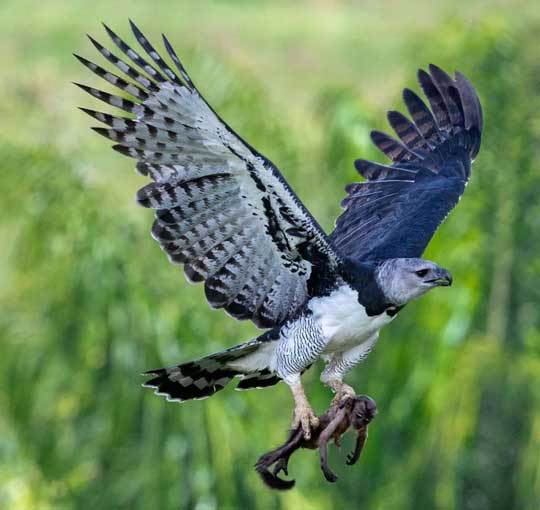
Harpy eagles are powerful birds. As I said above, they like hunting large prey, and the larger females have never been recorded taking a prey animal weighing less than 6 pounds (2.7 kg). They are often seen snatching and flying off with mature howler monkeys and sloths weighing up to 20 pounds (9.1 kg), which is equal to or heavier than the eagle itself.
Typically, these eagles are perch hunters. They fly from tree to tree then sit for a while to listen and look for movement. When they spot a prey animal, they swoop in and pluck it from the trees, or sometimes from the ground.
Harpy eagles have larger talons than any other living eagles, usually 3-4 inches (7.6-10.1 cm) long, and sometimes up to 5 inches (12.7 cm) long, longer than the claws of a grizzly bear. Harpy eagles have powerful clutching toes, and they typically use their long claws to kill their prey. Their beaks are powerful enough to easily crack mammal bones but are used mostly for feeding rather than killing.
Check out the impressive harpy eagle foot and talons below.

The harpy eagle is one of the few raptors (other than some owls) that has a facial disc. The harpy can puff out the feathers around its face to form a concave disc with its face in the center. Why? Because, like owls, these birds rely on sound to help them find their prey (the forest is rather dark under the thick rainforest canopy). The facial disc helps to funnel sound to their ears. When they puff up their feathers to do this, they often end up with some long feathers sticking up from the back of their head, making them look rather majestic.
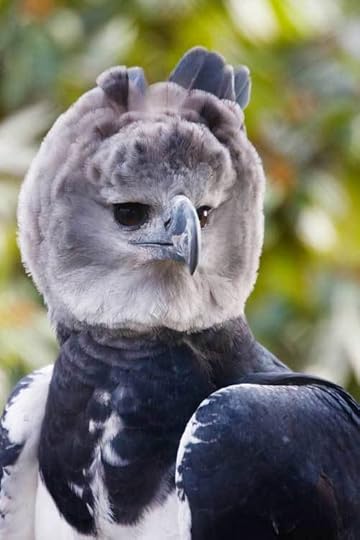
Check out this video about harpy eagles hunting.
Harpy eagles breed only once every two to three years. They are monogamous, and a pair will make a massive nest out of sticks. Even after the young hatch, the adults continuously add sticks that have green vegetation attached. This is thought to help keep the interior of the nest cool.
They typically lay two eggs, and the female incubates them for about 55 days. Surprisingly, when the first egg hatches, that young is nurtured, but the other egg is ignored, and the chick inside will die. Why? This allows the two parents to put all their energy into raising one healthy eaglet. You might wonder why they don't just lay one egg in the first place. By laying two, there is more likelihood that at least one will develop normally and hatch.

Two more tidbits of interesting information. The harpy eagle was used for inspiration for the design on the mythical creature Fawkes the Phoenix in the Harry Potter movies (as well as in the second Fantastic Beasts movie). Also, the harpy eagle is the national bird of Panama and is featured on the official Panama coat of arms.

So, the Harpy Eagle deserves a place in the I.A.H.O.F.
(Inimitable Animal Hall of Fame).
FUN FACT: The word inimitable originated way back in about 1525. It comes from the Latin word inimitabilis, which literally means "that cannot be imitated." The prefix in- means "the opposite of," and "imitabilis" means "imitable." So, anything that is inimitable cannot be imitated. The word is often confused with inimical, which means "harmful or hostile" (as in "a climate inimical to health"). However, if you can keep the two words straight, inimitable is a good way to express how unique (and often amazing) something or someone is, as in "Genesis Sequence is another of Stan Smith's inimitable novels."
So, inimitable is another way to say awesome!
Trish just told me she doesn't like either of the words, inimitable or inimical, because they are too hard to pronounce!
Photo Credits:
Harpy eagle #1, with head feathers up - DepositPhotos
Harpy eagle carrying monkey - Jiang Chunsheng, CC BY 4.0, via Wikimedia Commons
Harpy eagle foot - Carnivora
Harpy eagle face with head feathers up - "Harpy Eagle" by mirsasha is licensed under CC BY-NC-ND 2.0
Harpy eagle on nest with eaglet - DepositPhotos
Coat of Arms of Panama - Milenioscuro and Gumff, Public domain, via Wikimedia Commons

What the heck is a Harpy Eagle?
The harpy eagle (Harpia harpyja) is one of the largest, most powerful eagles in the world, and it lives and hunts in the canopy portion of tropical rainforests. Although the bird is rare, its range extends through Central America into much of South America, particularly Brazil. Unfortunately, except for Panama, it is almost extinct in Central America.
Harpy eagles were first described back in 1758, and they were named after the beasts of Greek mythology called harpies (fictional creatures with the body of a vulture and the face of a woman). the harpy eagle is most closely related to the crested eagle and the New Guinea harpy eagle.
Amazing Facts about the Harpy Eagle
First we need to talk about the hunting power of these birds. Harpy eagles have wing spans of about 6 feet (1.8 m), which is not particularly long for an eagle of this size (the smaller bald eagle can have a wing span of 7.5 feet). Why the shorter wings? Because most eagles hunt in open areas, where they can soar while they search for prey. Harpy eagles hunt in dense rainforest, where they need to be highly maneuverable. Their wings are short and very broad, which helps with maneuverability.
Harpy eagles are apex predators, at the top of their food chain, which means they have no predators to fear (other than humans). Occasionally they are attacked by jaguars or ocelots, but this is thought to be rare.
These birds don't mess around with small prey. Apparently they like the challenge of hunting larger animals. Although they feed on a variety of tree-dwelling animals, harpy eagles seem to prefer mammals, especially monkeys and sloths. Sloths can make up over half of their diet. Harpies ignore the smaller monkeys (like marmosets) and instead go for howler monkeys, capuchin monkeys, saki monkeys, titi monkeys, squirrel monkeys, and spider monkeys.
If a harpy eagle can't find a sloth or a monkey, it will happily kill and eat a porcupine, squirrel, opossum, anteater, armadillo, kinkajou, or coati.
Although they prefer mammals, these eagles will eat large parrots like macaws, iguanas and other large lizards, and snakes. Rarely, they even sometimes kill domestic chickens, lambs, goats, and pigs. One study showed that harpy eagles killed 102 different prey species!
Here is a harpy eagle that has just caught a monkey.

Harpy eagles are powerful birds. As I said above, they like hunting large prey, and the larger females have never been recorded taking a prey animal weighing less than 6 pounds (2.7 kg). They are often seen snatching and flying off with mature howler monkeys and sloths weighing up to 20 pounds (9.1 kg), which is equal to or heavier than the eagle itself.
Typically, these eagles are perch hunters. They fly from tree to tree then sit for a while to listen and look for movement. When they spot a prey animal, they swoop in and pluck it from the trees, or sometimes from the ground.
Harpy eagles have larger talons than any other living eagles, usually 3-4 inches (7.6-10.1 cm) long, and sometimes up to 5 inches (12.7 cm) long, longer than the claws of a grizzly bear. Harpy eagles have powerful clutching toes, and they typically use their long claws to kill their prey. Their beaks are powerful enough to easily crack mammal bones but are used mostly for feeding rather than killing.
Check out the impressive harpy eagle foot and talons below.

The harpy eagle is one of the few raptors (other than some owls) that has a facial disc. The harpy can puff out the feathers around its face to form a concave disc with its face in the center. Why? Because, like owls, these birds rely on sound to help them find their prey (the forest is rather dark under the thick rainforest canopy). The facial disc helps to funnel sound to their ears. When they puff up their feathers to do this, they often end up with some long feathers sticking up from the back of their head, making them look rather majestic.

Check out this video about harpy eagles hunting.
Harpy eagles breed only once every two to three years. They are monogamous, and a pair will make a massive nest out of sticks. Even after the young hatch, the adults continuously add sticks that have green vegetation attached. This is thought to help keep the interior of the nest cool.
They typically lay two eggs, and the female incubates them for about 55 days. Surprisingly, when the first egg hatches, that young is nurtured, but the other egg is ignored, and the chick inside will die. Why? This allows the two parents to put all their energy into raising one healthy eaglet. You might wonder why they don't just lay one egg in the first place. By laying two, there is more likelihood that at least one will develop normally and hatch.

Two more tidbits of interesting information. The harpy eagle was used for inspiration for the design on the mythical creature Fawkes the Phoenix in the Harry Potter movies (as well as in the second Fantastic Beasts movie). Also, the harpy eagle is the national bird of Panama and is featured on the official Panama coat of arms.

So, the Harpy Eagle deserves a place in the I.A.H.O.F.
(Inimitable Animal Hall of Fame).
FUN FACT: The word inimitable originated way back in about 1525. It comes from the Latin word inimitabilis, which literally means "that cannot be imitated." The prefix in- means "the opposite of," and "imitabilis" means "imitable." So, anything that is inimitable cannot be imitated. The word is often confused with inimical, which means "harmful or hostile" (as in "a climate inimical to health"). However, if you can keep the two words straight, inimitable is a good way to express how unique (and often amazing) something or someone is, as in "Genesis Sequence is another of Stan Smith's inimitable novels."
So, inimitable is another way to say awesome!
Trish just told me she doesn't like either of the words, inimitable or inimical, because they are too hard to pronounce!
Photo Credits:
Harpy eagle #1, with head feathers up - DepositPhotos
Harpy eagle carrying monkey - Jiang Chunsheng, CC BY 4.0, via Wikimedia Commons
Harpy eagle foot - Carnivora
Harpy eagle face with head feathers up - "Harpy Eagle" by mirsasha is licensed under CC BY-NC-ND 2.0
Harpy eagle on nest with eaglet - DepositPhotos
Coat of Arms of Panama - Milenioscuro and Gumff, Public domain, via Wikimedia Commons
Published on September 01, 2021 11:26
August 10, 2021
Awesome Animal - Murder Hornet
As a kid, when I was growing up in central Kansas (USA), my friends and I had an exaggerated fear of a large wasp called the cicada killer. Seriously. When we saw one, we would scream "Cicada killer!" and scatter as if our lives were in immediate peril. So, from a young age, I've had a healthy respect for stinging creatures.
Now everyone's talking about this mysterious demon called a murder hornet. Wow, what a name. The common name for the insect is actually Asian giant hornet. With all the buzz in the media (see what I did there?), we need to figure out what's real and what's exaggeration. Do we need to scream "murder hornet!" and run for our lives? Let's find out.
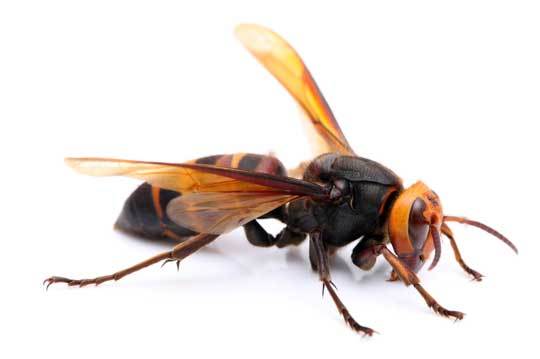 What the heck is a Murder Hornet?
What the heck is a Murder Hornet?
Again, I want to emphasize that murder hornet is not the real name. Therefore, from this point on I will refer to these insects as Asian giant hornets, or just giant hornets.
Asian giant hornets (Vespa mandarinia), are the world's largest hornets. They have a wing span of up to 3 inches (76 mm), and the stinger is 1/4 inch (6 mm) long. Their sting can deliver a relatively strong venom, and numerous stings can indeed kill a human (keep in mind this is true of some other hornets, bees, and wasps as well). They have a distinctive yellow head.
On average, the cicada killer wasp I mentioned above is actually about the same size or slightly larger than the Asian giant hornet (both can be up to 2 inches long), although there is a lot of variability between individuals of both species. Here they are side by side. The Asian giant hornet is a hornet, and the cicada killer is a wasp—two different groups.
Amazing Facts about Asian Giant Hornets
First, we need to talk about why these hornets have been so prominent in the news the last few years. Basically, it's because they are spreading. Specifically, they are showing up in the United States, and you know how the American news media can be, right? Is this cause for concern? Yes, but it is not cause for panic, as most people throughout the world have lived in close proximity to various stinging insects all their lives. Let's sort it out.
If these hornets can spread to the US, they can spread to other countries too. They live throughout Asia, and they are quite common in Japan. Japan, in fact, is where they were nicknamed murder hornets back in 2008.
Giant hornets can be dangerous, but so are other bees, wasps, and hornets, and so are other insects, like mosquitoes.
Here are some statistics. During the last two decades, in the United States there has been an average of 62 human deaths per year from bee, wasp, and hornet stings. In Japan, where Asian giant hornets are common, there has been an average of 21 deaths per year from bee, wasp, and hornet stings (giant hornets only cause a portion of those). Throughout all of Asia (a very large population of people), an average of 50 people die per year specifically from Asian giant hornets.
Just to put things into perspective, mosquitoes are responsible for millions of yearly deaths worldwide from malaria, dengue fever, and other diseases, according to the World Health Organization. Between 1700 and 1900, about 100,000 Americans were killed by mosquitoes carrying yellow fever.
Again, Asian giant hornets can be dangerous, but they are not cause for panic (unless you are a beekeeper... I'll get to that in a moment).
Below is a dead giant hornet, to give an idea of its size.
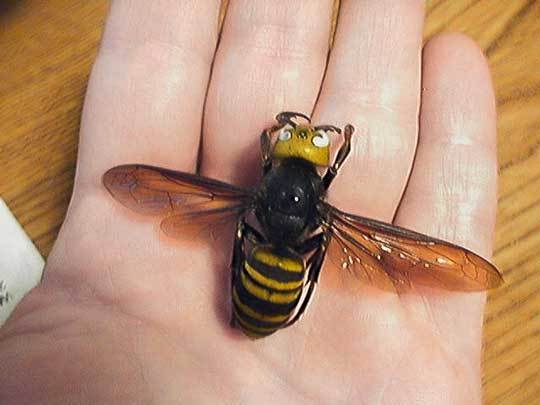
Asian giant hornets have a painful and dangerous sting. However, they are not aggressive toward humans unless they feel their nest is threatened.
Giant hornets have stingers that are much longer than those of most other wasps, bees, and hornets. Not only that, but because of this insect's size, they can inject seven times more venom than a honeybee can inject. The venom is particularly potent, and people describe it as being similar to getting a hot nail shoved into the skin.
The venom contains several kinds of toxins, including a neurotoxin called mandaratoxin. This neurotoxin from the sting of one wasp is enough to kill a mouse about 50% of the time. This is not usually enough to be dangerous to a human unless there are multiple stings. Obviously, an allergy to the venom increases the danger. Research shows that the majority of deaths occur as a result of cardiac arrest or anaphylactic shock resulting from numerous stings.
How many stings does it take? It depends on how allergic the person is, but here are some more statistics. Those people who have died were stung an average of 59 times each. Those people who were hospitalized but survived were stung an average of 29 times each. Remember, these are averages... which means some individuals were higher and some were lower.
In China, they recommend getting medical attention if stung 10 times or more, and 30 or more stings definitely requires emergency treatment.
Are these insects dangerous? Yes, they can be. Should everyone panic and move to an underground bunker? Nope. Most of us already live in areas where there are aggressive bees, wasps, and hornets, and have already learned to be cautious about approaching and threatening their nests.

The real danger of these hornets expanding into new territories is that they love to kill bees. In fact, that's how they actually got the nickname of murder hornets. Bees are essential pollinators. Beekeepers (and wild bees) help sustain dozens of essential agricultural crops, as well as countless non-agricultural native plants.
However, Asian giant hornets love killing bees! And they love honey. When a giant hornet finds a beehive, it releases a chemical that tells its buddies where the hive is, and soon an entire brigade of giant hornets descends upon the beehive like demons of the apocalypse. At five times the size of a honeybee, each giant hornet can kill 40 bees per minute. The hornets have jaws specially adapted for ripping the bees' heads from their bodies (see these "mandibles of death" below).
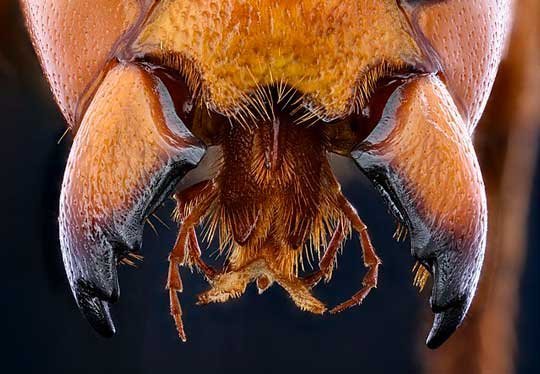
Incredibly, a few dozen giant hornets can wipe out an entire colony of over 10,000 honeybees in just a few hours. This could be devastating to bee populations (not to mention to the livelihood of beekeepers and honey producers).
Interestingly, Japanese honeybees, having evolved where giant hornets are common, have adapted defenses to this kind of attack. When they detect a single giant hornet near their hive, they attack en masse before the hornet can release its chemical to attract other hornets. The bees are too small to kill the hornet by fighting, so instead they pile onto it, enveloping it in a mass of bees, then they vibrate their bodies at an extremely fast rate. This creates so much heat that they roast the hornet alive. Awesome, huh?
Check out this video about how Japanese honeybees do this.
So, for many reasons, giant hornets are not welcome outside of their native range—not in the United States nor anywhere else. Fortunately, there are ways to get rid of these invasive murderers. Poisons, baited traps, controlled fires, and strategic uses of screens over nesting areas are possible eradication methods.
Even though these creatures are unwanted outside of their native range, they are still awesome animals. They are amazing apex insect predators, with impressive adaptations. Consider sharks... sharks are awesome animals, although you wouldn't want a bunch of them to invade your neighborhood swimming pool.
So, the Murder Hornet deserves a place in the F.A.H.O.F.
(Fabulous Animal Hall of Fame).
FUN FACT: The word fabulous originated in the early 1400s, from the Latin word fabulosus. Its original meaning was "mythical, legendary." In other words, it implied that something was not actually true (this seems appropriate for the "murder hornet" because of all the misinformation about them). In about 1600, it began to be used to mean "incredible," as in "enormous, immense, amazing" (again, appropriate for this animal). Finally, in the 1950s, it was changed to mean simply "marvelous, terrific." A shortened form of it, fab, became popular in 1963 to refer to The Beatles (the Fab Four).
So, fabulous is another way to say awesome! Photo Credits:
Asian giant hornet on white background - DepositPhotos
Asian giant hornet in hand - NUMBER7isBEST, CC BY-SA 4.0, via Wikimedia Commons
Four hornets on a rock - DepositPhotos
Giant hornet mandibles - USGS Bee Inventory and Monitoring Lab from Beltsville, Maryland, USA, Public domain, via Wikimedia Commons
Now everyone's talking about this mysterious demon called a murder hornet. Wow, what a name. The common name for the insect is actually Asian giant hornet. With all the buzz in the media (see what I did there?), we need to figure out what's real and what's exaggeration. Do we need to scream "murder hornet!" and run for our lives? Let's find out.
 What the heck is a Murder Hornet?
What the heck is a Murder Hornet?Again, I want to emphasize that murder hornet is not the real name. Therefore, from this point on I will refer to these insects as Asian giant hornets, or just giant hornets.
Asian giant hornets (Vespa mandarinia), are the world's largest hornets. They have a wing span of up to 3 inches (76 mm), and the stinger is 1/4 inch (6 mm) long. Their sting can deliver a relatively strong venom, and numerous stings can indeed kill a human (keep in mind this is true of some other hornets, bees, and wasps as well). They have a distinctive yellow head.
On average, the cicada killer wasp I mentioned above is actually about the same size or slightly larger than the Asian giant hornet (both can be up to 2 inches long), although there is a lot of variability between individuals of both species. Here they are side by side. The Asian giant hornet is a hornet, and the cicada killer is a wasp—two different groups.

Amazing Facts about Asian Giant Hornets
First, we need to talk about why these hornets have been so prominent in the news the last few years. Basically, it's because they are spreading. Specifically, they are showing up in the United States, and you know how the American news media can be, right? Is this cause for concern? Yes, but it is not cause for panic, as most people throughout the world have lived in close proximity to various stinging insects all their lives. Let's sort it out.
If these hornets can spread to the US, they can spread to other countries too. They live throughout Asia, and they are quite common in Japan. Japan, in fact, is where they were nicknamed murder hornets back in 2008.
Giant hornets can be dangerous, but so are other bees, wasps, and hornets, and so are other insects, like mosquitoes.
Here are some statistics. During the last two decades, in the United States there has been an average of 62 human deaths per year from bee, wasp, and hornet stings. In Japan, where Asian giant hornets are common, there has been an average of 21 deaths per year from bee, wasp, and hornet stings (giant hornets only cause a portion of those). Throughout all of Asia (a very large population of people), an average of 50 people die per year specifically from Asian giant hornets.
Just to put things into perspective, mosquitoes are responsible for millions of yearly deaths worldwide from malaria, dengue fever, and other diseases, according to the World Health Organization. Between 1700 and 1900, about 100,000 Americans were killed by mosquitoes carrying yellow fever.
Again, Asian giant hornets can be dangerous, but they are not cause for panic (unless you are a beekeeper... I'll get to that in a moment).
Below is a dead giant hornet, to give an idea of its size.

Asian giant hornets have a painful and dangerous sting. However, they are not aggressive toward humans unless they feel their nest is threatened.
Giant hornets have stingers that are much longer than those of most other wasps, bees, and hornets. Not only that, but because of this insect's size, they can inject seven times more venom than a honeybee can inject. The venom is particularly potent, and people describe it as being similar to getting a hot nail shoved into the skin.
The venom contains several kinds of toxins, including a neurotoxin called mandaratoxin. This neurotoxin from the sting of one wasp is enough to kill a mouse about 50% of the time. This is not usually enough to be dangerous to a human unless there are multiple stings. Obviously, an allergy to the venom increases the danger. Research shows that the majority of deaths occur as a result of cardiac arrest or anaphylactic shock resulting from numerous stings.
How many stings does it take? It depends on how allergic the person is, but here are some more statistics. Those people who have died were stung an average of 59 times each. Those people who were hospitalized but survived were stung an average of 29 times each. Remember, these are averages... which means some individuals were higher and some were lower.
In China, they recommend getting medical attention if stung 10 times or more, and 30 or more stings definitely requires emergency treatment.
Are these insects dangerous? Yes, they can be. Should everyone panic and move to an underground bunker? Nope. Most of us already live in areas where there are aggressive bees, wasps, and hornets, and have already learned to be cautious about approaching and threatening their nests.

The real danger of these hornets expanding into new territories is that they love to kill bees. In fact, that's how they actually got the nickname of murder hornets. Bees are essential pollinators. Beekeepers (and wild bees) help sustain dozens of essential agricultural crops, as well as countless non-agricultural native plants.
However, Asian giant hornets love killing bees! And they love honey. When a giant hornet finds a beehive, it releases a chemical that tells its buddies where the hive is, and soon an entire brigade of giant hornets descends upon the beehive like demons of the apocalypse. At five times the size of a honeybee, each giant hornet can kill 40 bees per minute. The hornets have jaws specially adapted for ripping the bees' heads from their bodies (see these "mandibles of death" below).

Incredibly, a few dozen giant hornets can wipe out an entire colony of over 10,000 honeybees in just a few hours. This could be devastating to bee populations (not to mention to the livelihood of beekeepers and honey producers).
Interestingly, Japanese honeybees, having evolved where giant hornets are common, have adapted defenses to this kind of attack. When they detect a single giant hornet near their hive, they attack en masse before the hornet can release its chemical to attract other hornets. The bees are too small to kill the hornet by fighting, so instead they pile onto it, enveloping it in a mass of bees, then they vibrate their bodies at an extremely fast rate. This creates so much heat that they roast the hornet alive. Awesome, huh?
Check out this video about how Japanese honeybees do this.
So, for many reasons, giant hornets are not welcome outside of their native range—not in the United States nor anywhere else. Fortunately, there are ways to get rid of these invasive murderers. Poisons, baited traps, controlled fires, and strategic uses of screens over nesting areas are possible eradication methods.
Even though these creatures are unwanted outside of their native range, they are still awesome animals. They are amazing apex insect predators, with impressive adaptations. Consider sharks... sharks are awesome animals, although you wouldn't want a bunch of them to invade your neighborhood swimming pool.
So, the Murder Hornet deserves a place in the F.A.H.O.F.
(Fabulous Animal Hall of Fame).
FUN FACT: The word fabulous originated in the early 1400s, from the Latin word fabulosus. Its original meaning was "mythical, legendary." In other words, it implied that something was not actually true (this seems appropriate for the "murder hornet" because of all the misinformation about them). In about 1600, it began to be used to mean "incredible," as in "enormous, immense, amazing" (again, appropriate for this animal). Finally, in the 1950s, it was changed to mean simply "marvelous, terrific." A shortened form of it, fab, became popular in 1963 to refer to The Beatles (the Fab Four).
So, fabulous is another way to say awesome! Photo Credits:
Asian giant hornet on white background - DepositPhotos
Asian giant hornet in hand - NUMBER7isBEST, CC BY-SA 4.0, via Wikimedia Commons
Four hornets on a rock - DepositPhotos
Giant hornet mandibles - USGS Bee Inventory and Monitoring Lab from Beltsville, Maryland, USA, Public domain, via Wikimedia Commons
Published on August 10, 2021 07:41
July 27, 2021
Awesome Animal - Frogmouth
In 1995, Trish and I were lucky enough to tour a fascinating cave in New Zealand. As we came out of the cave, there was a funny-looking bird sitting on a handrail within arm's reach of me. The bird simply stared, with no apparent urge to fly away. It had a cartoon-like face and a wide mouth that reminded me of a frog's mouth. In fact, this bird was actually a tawny frogmouth. 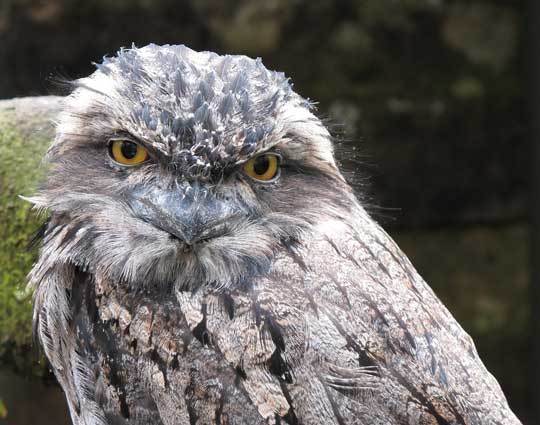
What the heck is a Frogmouth?
First of all, despite their owl-like appearance, frogmouths are not owls. They are actually related to nightjars (the nightjars are insect-eating birds with short, broad beaks... in Missouri we have three nightjars, the nighthawk, the whip-poor-will, and the chuck-will's-widow). However, frogmouths are often mistaken for owls because they are nocturnal and their feather coloration is similar to some owls.
This similar appearance is a great example of convergent evolution, in which unrelated organisms evolve to look similar to each other because they are adapted to similar habitats and habits. Owls and frogmouths both hunt at night, so they both have large eyes and similar camouflage patterns. However, frogmouths do not have strong claws like owls. Owls use their claws to hunt larger prey, whereas frogmouths catch insects and small vertebrates with their mouths instead of their talons. They can open their mouths wide to scoop up flying insects.
Frogmouths live across much of Southeast Asia and Australia. There are 14 species of frogmouths, but the tawny frogmouth is arguably the best known of all of them. Well, at least it's the one most frequently seen on the internet. In fact, in April 2021, German researchers did a study using an algorithm to analyze the aesthetic appeal of over 27,000 bird photos and found that Instagram users "liked" frogmouth photos more than any other bird photos.
Therefore, frogmouths are officially the world's most Instagrammable bird species.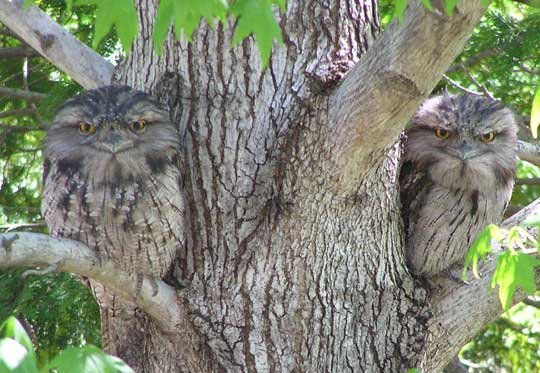
Amazing Facts about Frogmouths
First, I recommend that you watch this fun video about frogmouths. It's worth the five minutes of your life that it will take to watch it.
Okay, if you watched the video, you probably want to know more, right? Like, did he say frogmouths bash their prey against rocks? He did indeed. Remember, owls have strong claws for killing, frogmouths don't (their feet are small and rather weak). Instead, they have... well, big mouths. They can grab prey animals that are bigger than insects (frogs, reptiles, small birds and mammals), but instead of tearing them apart with talons, they whip them against a rock or tree over and over. Then they swallow the bashed-up creature in one gulp.
That's dramatic, I suppose, but the majority of a frogmouth's diet is smaller critters—nocturnal insects, slugs, snails, and worms. Most of these they see from their perch in a tree and pounce onto them on the ground. Sometimes they catch insects in flight, which unfortunately leads to these birds being hit by cars while swooping in to catch insects attracted to bright headlights.
Frogmouths are really good at camouflage. You can see from the photo above that their color allows them to blend in, but that's just the beginning. When they sense danger, they get into a position that makes them look like a broken branch on the tree. Sometimes they will even sway back and forth as if the wind is blowing the tree. Frogmouths actually seek out old trees to sit in because it's easier for them to look like an old, stumpy tree limb.
Below is a Javan frogmouth on its nest, trying to look invisible.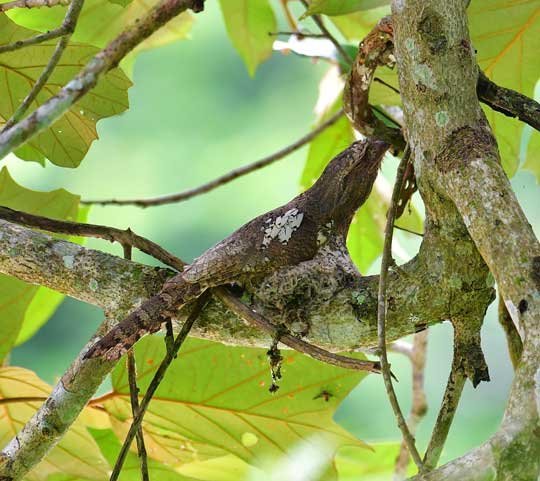
I guess we need to talk about the pitiful nests these birds create (see photo above). When it comes to nest-making, frogmouths definitely would not win the Engineer-Of-The-Year award. Their nests are rather minimalistic. Sometimes they lay their eggs in the fork of a tree with hardly any nest at all. Sometimes they place a few sticks together and call it a nest. Or they use a bit of moss, lichens, or leaves. These nests are well camouflaged, but they don't do much to keep the eggs from falling out of the tree, which definitely happens sometimes.
Well, perhaps they don't make the most impressive nests, but that's not to say they don't excel in other aspects of parenting. Frogmouths are excellent at sharing the duties. They are known to mate for life, and both sexes sit on the eggs—the male sits on the nest all day long, but then the male and female take turns during the night so they can both go out hunting for food. So, even though the nest is wimpy, the eggs and young are almost never left unattended. Both parents work hard to provide food for the growing chicks.
Below is a Hodgson frogmouth sitting on its nest with two chicks. I can't decide if those chicks are cute or scary-looking.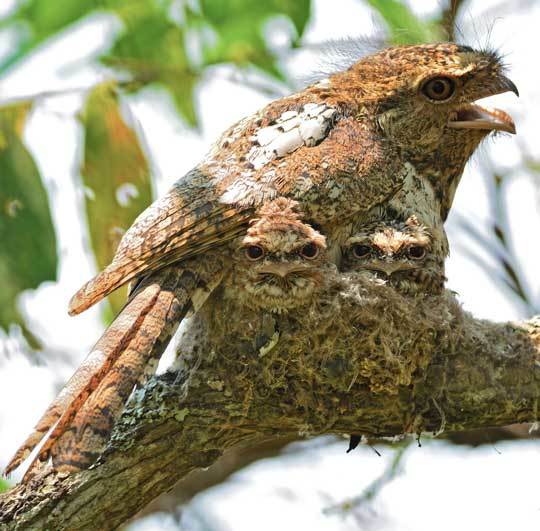
Frogmouths have a strange call. Sometimes they hiss or growl if they feel threatened, but their usual call is a low, monotonous wooo-wooo-wooo. Check out this video (you need to listen carefully... you can hear it in the last half).
Frogmouths are good at surviving extreme temperatures. When temps get really low and food becomes scarce, frogmouths are able to go into a dormant state called torpor. This drastically lowers their heart rate, metabolic rate, and temperature, which therefore reduces their need for food. Torpor is not the same as hibernation. Hibernation is a long-term state, whereas torpor is usually only a few hours at a time. Still, frogmouths can go into torpor repeatedly, spending much of the days and nights of the cold season in a low-energy state.
In the hot months, frogmouths open their mouths and pant. The moving air helps cool them down. To increase the effectiveness of this, they fill their mouths with mucus, which helps cool the air as it is inhaled.
I mentioned above that frogmouths often mate for life. Continuous close proximity and physical touch seem to be important ways for frogmouth pairs to reinforce their bond (Hey, I can identify with that!). Pairs typically spend their down time sitting beside each other, even close enough that they are touching. A male often grooms the female's feathers, sometimes doing this for up to ten minutes without stopping.
Below is a bonding pair of Sri Lanka frogmouths.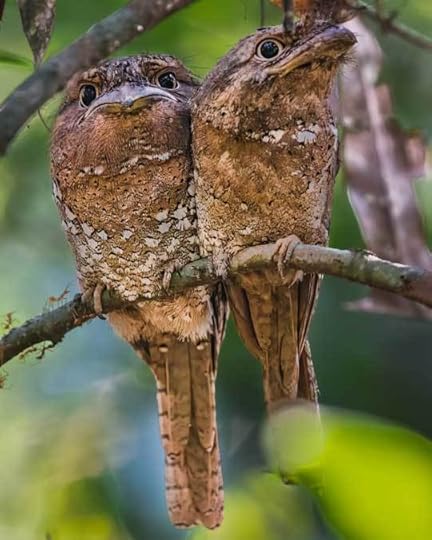
So, the Frogmouth deserves a place in the P.A.H.O.F.
(Portentous Animal Hall of Fame).
FUN FACT: The word portentous originated way back in the 1540s. In fact, it was seemingly a favorite word of William Shakespeare. It came from the Latin word portentosus. The root of the word, portent, was a synonym of a sign or an omen. When the word portentous was first used, it was always in reference to an omen, usually a bad omen. However, by the end of the 1500s, the word began being used as a synonym for prodigious, which means "remarkable or impressively great in extent, size, or degree." Today, many years later, the word is often used to mean "trying to appear important and serious." Well, take one look at the frogmouth and you'll agree this definition fits. Frogmouths look very important and serious to me.
So, more or less, portentous is another way to say awesome! Photo Credits:
Tawny frogmouth #1 - DepositPhotos
Two tawny frogmouths on opposite sides of tree trunk - Keith Edkins, Wikimedia Commons
Javan frogmouth on nest - camouflage - DepositPhotos
Hodgson frogmouth with two chicks in nest - DepositPhotos
Pair of Sri Lanka frogmouths - DepositPhotos

What the heck is a Frogmouth?
First of all, despite their owl-like appearance, frogmouths are not owls. They are actually related to nightjars (the nightjars are insect-eating birds with short, broad beaks... in Missouri we have three nightjars, the nighthawk, the whip-poor-will, and the chuck-will's-widow). However, frogmouths are often mistaken for owls because they are nocturnal and their feather coloration is similar to some owls.
This similar appearance is a great example of convergent evolution, in which unrelated organisms evolve to look similar to each other because they are adapted to similar habitats and habits. Owls and frogmouths both hunt at night, so they both have large eyes and similar camouflage patterns. However, frogmouths do not have strong claws like owls. Owls use their claws to hunt larger prey, whereas frogmouths catch insects and small vertebrates with their mouths instead of their talons. They can open their mouths wide to scoop up flying insects.
Frogmouths live across much of Southeast Asia and Australia. There are 14 species of frogmouths, but the tawny frogmouth is arguably the best known of all of them. Well, at least it's the one most frequently seen on the internet. In fact, in April 2021, German researchers did a study using an algorithm to analyze the aesthetic appeal of over 27,000 bird photos and found that Instagram users "liked" frogmouth photos more than any other bird photos.
Therefore, frogmouths are officially the world's most Instagrammable bird species.

Amazing Facts about Frogmouths
First, I recommend that you watch this fun video about frogmouths. It's worth the five minutes of your life that it will take to watch it.
Okay, if you watched the video, you probably want to know more, right? Like, did he say frogmouths bash their prey against rocks? He did indeed. Remember, owls have strong claws for killing, frogmouths don't (their feet are small and rather weak). Instead, they have... well, big mouths. They can grab prey animals that are bigger than insects (frogs, reptiles, small birds and mammals), but instead of tearing them apart with talons, they whip them against a rock or tree over and over. Then they swallow the bashed-up creature in one gulp.
That's dramatic, I suppose, but the majority of a frogmouth's diet is smaller critters—nocturnal insects, slugs, snails, and worms. Most of these they see from their perch in a tree and pounce onto them on the ground. Sometimes they catch insects in flight, which unfortunately leads to these birds being hit by cars while swooping in to catch insects attracted to bright headlights.
Frogmouths are really good at camouflage. You can see from the photo above that their color allows them to blend in, but that's just the beginning. When they sense danger, they get into a position that makes them look like a broken branch on the tree. Sometimes they will even sway back and forth as if the wind is blowing the tree. Frogmouths actually seek out old trees to sit in because it's easier for them to look like an old, stumpy tree limb.
Below is a Javan frogmouth on its nest, trying to look invisible.

I guess we need to talk about the pitiful nests these birds create (see photo above). When it comes to nest-making, frogmouths definitely would not win the Engineer-Of-The-Year award. Their nests are rather minimalistic. Sometimes they lay their eggs in the fork of a tree with hardly any nest at all. Sometimes they place a few sticks together and call it a nest. Or they use a bit of moss, lichens, or leaves. These nests are well camouflaged, but they don't do much to keep the eggs from falling out of the tree, which definitely happens sometimes.
Well, perhaps they don't make the most impressive nests, but that's not to say they don't excel in other aspects of parenting. Frogmouths are excellent at sharing the duties. They are known to mate for life, and both sexes sit on the eggs—the male sits on the nest all day long, but then the male and female take turns during the night so they can both go out hunting for food. So, even though the nest is wimpy, the eggs and young are almost never left unattended. Both parents work hard to provide food for the growing chicks.
Below is a Hodgson frogmouth sitting on its nest with two chicks. I can't decide if those chicks are cute or scary-looking.

Frogmouths have a strange call. Sometimes they hiss or growl if they feel threatened, but their usual call is a low, monotonous wooo-wooo-wooo. Check out this video (you need to listen carefully... you can hear it in the last half).
Frogmouths are good at surviving extreme temperatures. When temps get really low and food becomes scarce, frogmouths are able to go into a dormant state called torpor. This drastically lowers their heart rate, metabolic rate, and temperature, which therefore reduces their need for food. Torpor is not the same as hibernation. Hibernation is a long-term state, whereas torpor is usually only a few hours at a time. Still, frogmouths can go into torpor repeatedly, spending much of the days and nights of the cold season in a low-energy state.
In the hot months, frogmouths open their mouths and pant. The moving air helps cool them down. To increase the effectiveness of this, they fill their mouths with mucus, which helps cool the air as it is inhaled.
I mentioned above that frogmouths often mate for life. Continuous close proximity and physical touch seem to be important ways for frogmouth pairs to reinforce their bond (Hey, I can identify with that!). Pairs typically spend their down time sitting beside each other, even close enough that they are touching. A male often grooms the female's feathers, sometimes doing this for up to ten minutes without stopping.
Below is a bonding pair of Sri Lanka frogmouths.

So, the Frogmouth deserves a place in the P.A.H.O.F.
(Portentous Animal Hall of Fame).
FUN FACT: The word portentous originated way back in the 1540s. In fact, it was seemingly a favorite word of William Shakespeare. It came from the Latin word portentosus. The root of the word, portent, was a synonym of a sign or an omen. When the word portentous was first used, it was always in reference to an omen, usually a bad omen. However, by the end of the 1500s, the word began being used as a synonym for prodigious, which means "remarkable or impressively great in extent, size, or degree." Today, many years later, the word is often used to mean "trying to appear important and serious." Well, take one look at the frogmouth and you'll agree this definition fits. Frogmouths look very important and serious to me.
So, more or less, portentous is another way to say awesome! Photo Credits:
Tawny frogmouth #1 - DepositPhotos
Two tawny frogmouths on opposite sides of tree trunk - Keith Edkins, Wikimedia Commons
Javan frogmouth on nest - camouflage - DepositPhotos
Hodgson frogmouth with two chicks in nest - DepositPhotos
Pair of Sri Lanka frogmouths - DepositPhotos
Published on July 27, 2021 08:16
July 17, 2021
Awesome Animal - Flying Dragon
Way back in 1758 Carl Linnaeus described a type of lizard that had strange flaps of skin on its sides that looked almost like wings. He named the genus Draco, which is from the Latin word for dragons... you know, those giant, mythical flying reptiles. Back then, scientists did not know if the wing-like flaps of skin were actually for flying. In fact, this possibility was debated all the way into the mid 1950s. Many scientists thought the flaps were used only for threat displays or mating displays. Finally, in the 1950s, scientists actually observed the lizards gliding from tree to tree on these flaps of skin.

What the heck is a Flying Dragon?
Normally I share a YouTube video closer to the end of the Awesome Animal feature, but in this case I think you need to see the video first, in order to fully appreciate the awesomeness of these lizards before I go into more detail.
Check out this must-see video from the BBC.
See what I mean? Impressive lizards!
There are actually about forty species of Draco flying dragons, and they live in dense forests in Bornea, the Philippines, and across southeast Asia into southern India. They are fairly small lizards, averaging about 8 inches (20 cm) in length, including the tail, and they are all insectivores, gobbling up numerous insects per day.
Typically, they are drab in color, but their wing-like membranes, called patagia, can be brightly colored.
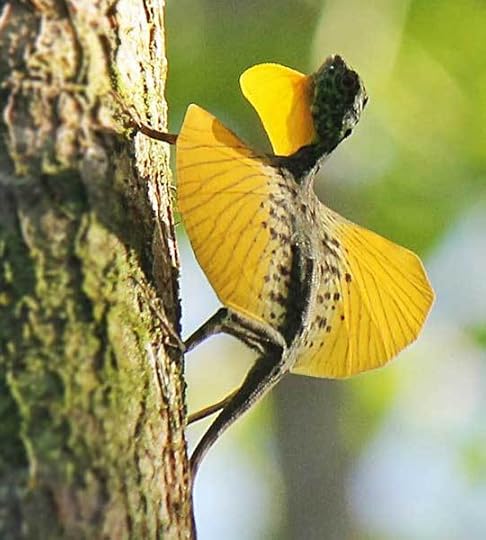
Amazing Facts about Flying Dragons
First, we need to talk about this whole flying thing. What the heck—a flying lizard? Not exactly. When it comes to animals, the word flying usually refers to the animal's ability to propel itself through the air under its own power for a sustained period of time. Birds, bats, and many insects can actually fly. Pterosaurs were real flying reptiles, and they could flap their wings for sustained flight, but they went extinct about 66 million years ago.
Draco flying dragons are not miniature pterosaurs, and they cannot fly. Instead, they are lizards, and they glide instead of fly (kind of like flying squirrels, which I featured in a recent email).
Don't let that fool you, though! Draco lizards are really good at gliding. They sail through the air with precision control, and people have observed them gliding as far as 200 feet (60 m) between trees. Look out your window at a tree that is 200 feet away. That gives you an idea of how impressive this feat is.

By the way... look at the lizard on the right (on the tree) in the photo above. That is what they look like when their wings are not spread out—pretty much like a normal lizard.
How exactly do Draco lizards glide? That impressive patagial membrane (wing) is supported by special, elongated rib bones, which the lizard can spread wide after it takes to the air, using certain muscles that other lizards usually use to control their breathing. The lizard leaps from a tree and spreads its ribs, which spreads the patagial membranes on both sides of its body. It then grabs the membranes with its forefeet to hold them out, then arches its back to force the wings into a concave shape, which enhances lift. The lizard controls its flight path by moving the wings up and down with its forelimbs.
Check out those elongated ribs!
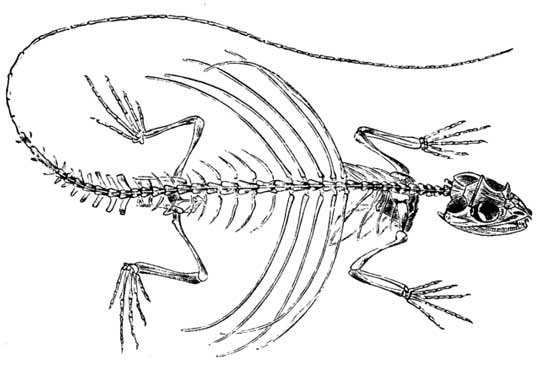
Okay, that makes sense. Now, WHY do Draco lizards glide? Remember, lizards are gobbled up by numerous predators. Walking around on the ground to get from tree to tree is dangerous business. So, there is a huge advantage to being able to glide between trees.
Maybe a better question is, why don't all lizards glide? There are many different answers. Not all lizards are small enough to glide. Not all lizards live in densely-forested areas (no point in gliding in a desert or grassland, right?). And there are numerous other reasons why not all lizards can glide. The question is kind of like asking, if gliding is good for Draco lizards, why can't people glide too?
In the past there have been other lizard species (now extinct) that have independently evolved this same ability. For example, there was a family of gliding lizards called Kuehneosauridae that lived during the Triassic period (251 to 201 million years ago). Their fossils show a similar structure to today's Draco lizards (see artist depiction below).
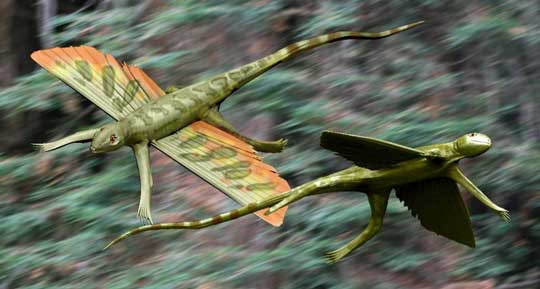
Male flying dragons also use their "wings" as displays to impress females. This is probably why some of them have brightly-colored patagia. In addition to their patagia, the males also have dewlaps, colorful folds of skin beneath the chin that males can extend to further add to their impressiveness (see below).
The males establish territories and guard them fiercely to keep other males out. Of course, the females are always welcome, and they move from territory to territory, checking out the males to see which one they are most impressed with.

So, the Flying Dragon deserves a place in the C.A.H.O.F.
(Choice Animal Hall of Fame).
FUN FACT: The word choice originated as a noun in about 1300. It came from the earlier French word chois, and its original meaning was "action of selecting" or "power of choosing" (as in, "I have no choice—I must read Stan's new book"). In the late 1300s, the word was also used as a noun for "the person or thing chosen" (as in, "Stan's new book is going to be my next choice"). Sometime in the mid 1300s, people began using the word as an adjective to mean "worthy of being chosen; excellent; superior" (as in, "Stan's new book will be one of the choice novels of our generation").
So, choice is another way to say awesome!
Photo Credits:
Flying dragon gliding #1 - Psumuseum, CC BY-SA 3.0, via Wikimedia Commons
Flying dragon on tree with yellow patagia spread open - A.S.Kono, CC BY-SA 3.0, via Wikimedia Commons
Flying dragon landing on a tree - DepositPhotos
Flying dragon skeleton diagram - Wikimedia Commons
Prehistoric gliding lizard art - Nobu Tamura (http://spinops.blogspot.com), CC BY 3.0, via Wikimedia Commons
Draco volans displaying with dewlap - DepositPhotos

What the heck is a Flying Dragon?
Normally I share a YouTube video closer to the end of the Awesome Animal feature, but in this case I think you need to see the video first, in order to fully appreciate the awesomeness of these lizards before I go into more detail.
Check out this must-see video from the BBC.
See what I mean? Impressive lizards!
There are actually about forty species of Draco flying dragons, and they live in dense forests in Bornea, the Philippines, and across southeast Asia into southern India. They are fairly small lizards, averaging about 8 inches (20 cm) in length, including the tail, and they are all insectivores, gobbling up numerous insects per day.
Typically, they are drab in color, but their wing-like membranes, called patagia, can be brightly colored.

Amazing Facts about Flying Dragons
First, we need to talk about this whole flying thing. What the heck—a flying lizard? Not exactly. When it comes to animals, the word flying usually refers to the animal's ability to propel itself through the air under its own power for a sustained period of time. Birds, bats, and many insects can actually fly. Pterosaurs were real flying reptiles, and they could flap their wings for sustained flight, but they went extinct about 66 million years ago.
Draco flying dragons are not miniature pterosaurs, and they cannot fly. Instead, they are lizards, and they glide instead of fly (kind of like flying squirrels, which I featured in a recent email).
Don't let that fool you, though! Draco lizards are really good at gliding. They sail through the air with precision control, and people have observed them gliding as far as 200 feet (60 m) between trees. Look out your window at a tree that is 200 feet away. That gives you an idea of how impressive this feat is.

By the way... look at the lizard on the right (on the tree) in the photo above. That is what they look like when their wings are not spread out—pretty much like a normal lizard.
How exactly do Draco lizards glide? That impressive patagial membrane (wing) is supported by special, elongated rib bones, which the lizard can spread wide after it takes to the air, using certain muscles that other lizards usually use to control their breathing. The lizard leaps from a tree and spreads its ribs, which spreads the patagial membranes on both sides of its body. It then grabs the membranes with its forefeet to hold them out, then arches its back to force the wings into a concave shape, which enhances lift. The lizard controls its flight path by moving the wings up and down with its forelimbs.
Check out those elongated ribs!

Okay, that makes sense. Now, WHY do Draco lizards glide? Remember, lizards are gobbled up by numerous predators. Walking around on the ground to get from tree to tree is dangerous business. So, there is a huge advantage to being able to glide between trees.
Maybe a better question is, why don't all lizards glide? There are many different answers. Not all lizards are small enough to glide. Not all lizards live in densely-forested areas (no point in gliding in a desert or grassland, right?). And there are numerous other reasons why not all lizards can glide. The question is kind of like asking, if gliding is good for Draco lizards, why can't people glide too?
In the past there have been other lizard species (now extinct) that have independently evolved this same ability. For example, there was a family of gliding lizards called Kuehneosauridae that lived during the Triassic period (251 to 201 million years ago). Their fossils show a similar structure to today's Draco lizards (see artist depiction below).

Male flying dragons also use their "wings" as displays to impress females. This is probably why some of them have brightly-colored patagia. In addition to their patagia, the males also have dewlaps, colorful folds of skin beneath the chin that males can extend to further add to their impressiveness (see below).
The males establish territories and guard them fiercely to keep other males out. Of course, the females are always welcome, and they move from territory to territory, checking out the males to see which one they are most impressed with.

So, the Flying Dragon deserves a place in the C.A.H.O.F.
(Choice Animal Hall of Fame).
FUN FACT: The word choice originated as a noun in about 1300. It came from the earlier French word chois, and its original meaning was "action of selecting" or "power of choosing" (as in, "I have no choice—I must read Stan's new book"). In the late 1300s, the word was also used as a noun for "the person or thing chosen" (as in, "Stan's new book is going to be my next choice"). Sometime in the mid 1300s, people began using the word as an adjective to mean "worthy of being chosen; excellent; superior" (as in, "Stan's new book will be one of the choice novels of our generation").
So, choice is another way to say awesome!
Photo Credits:
Flying dragon gliding #1 - Psumuseum, CC BY-SA 3.0, via Wikimedia Commons
Flying dragon on tree with yellow patagia spread open - A.S.Kono, CC BY-SA 3.0, via Wikimedia Commons
Flying dragon landing on a tree - DepositPhotos
Flying dragon skeleton diagram - Wikimedia Commons
Prehistoric gliding lizard art - Nobu Tamura (http://spinops.blogspot.com), CC BY 3.0, via Wikimedia Commons
Draco volans displaying with dewlap - DepositPhotos
Published on July 17, 2021 14:39



